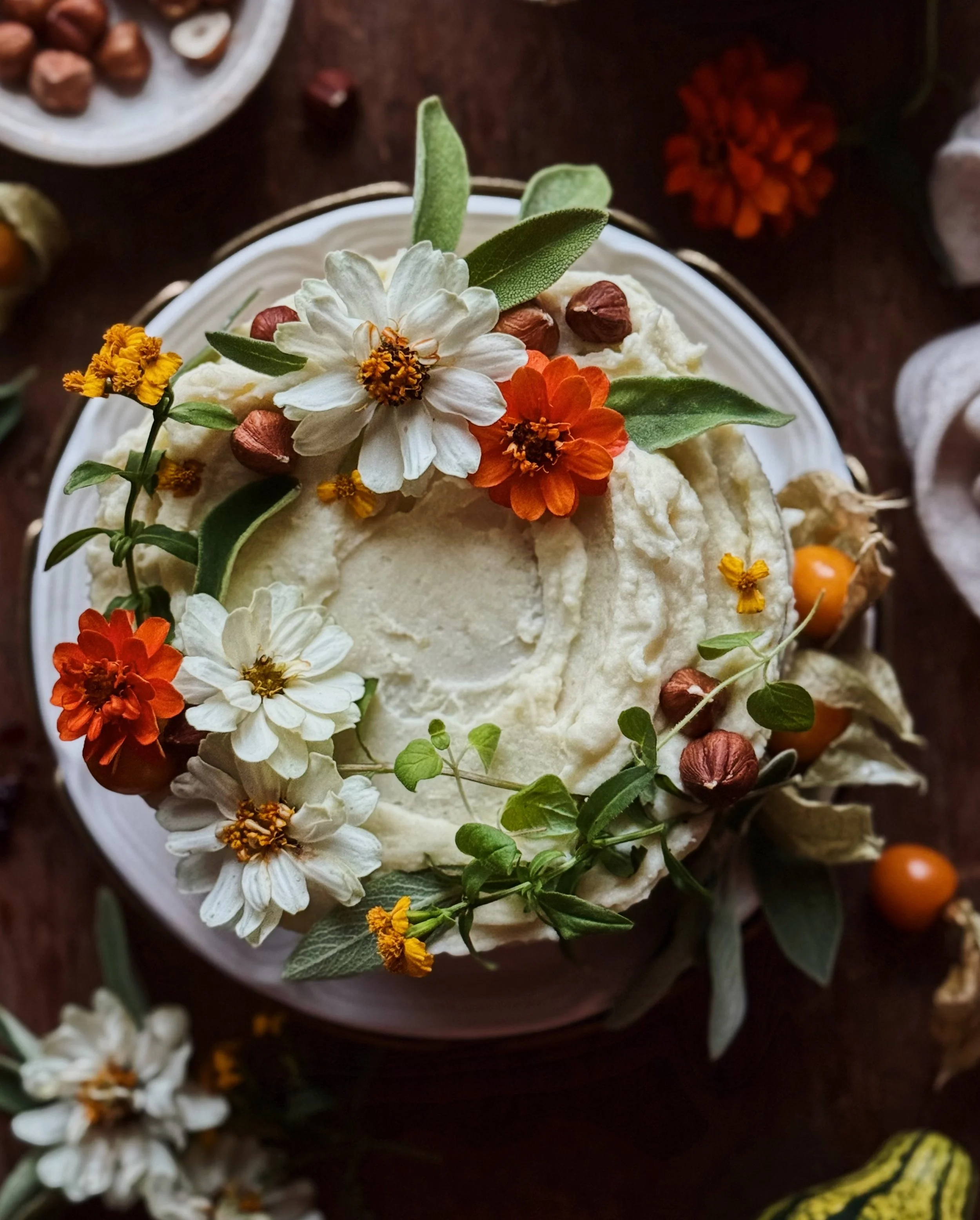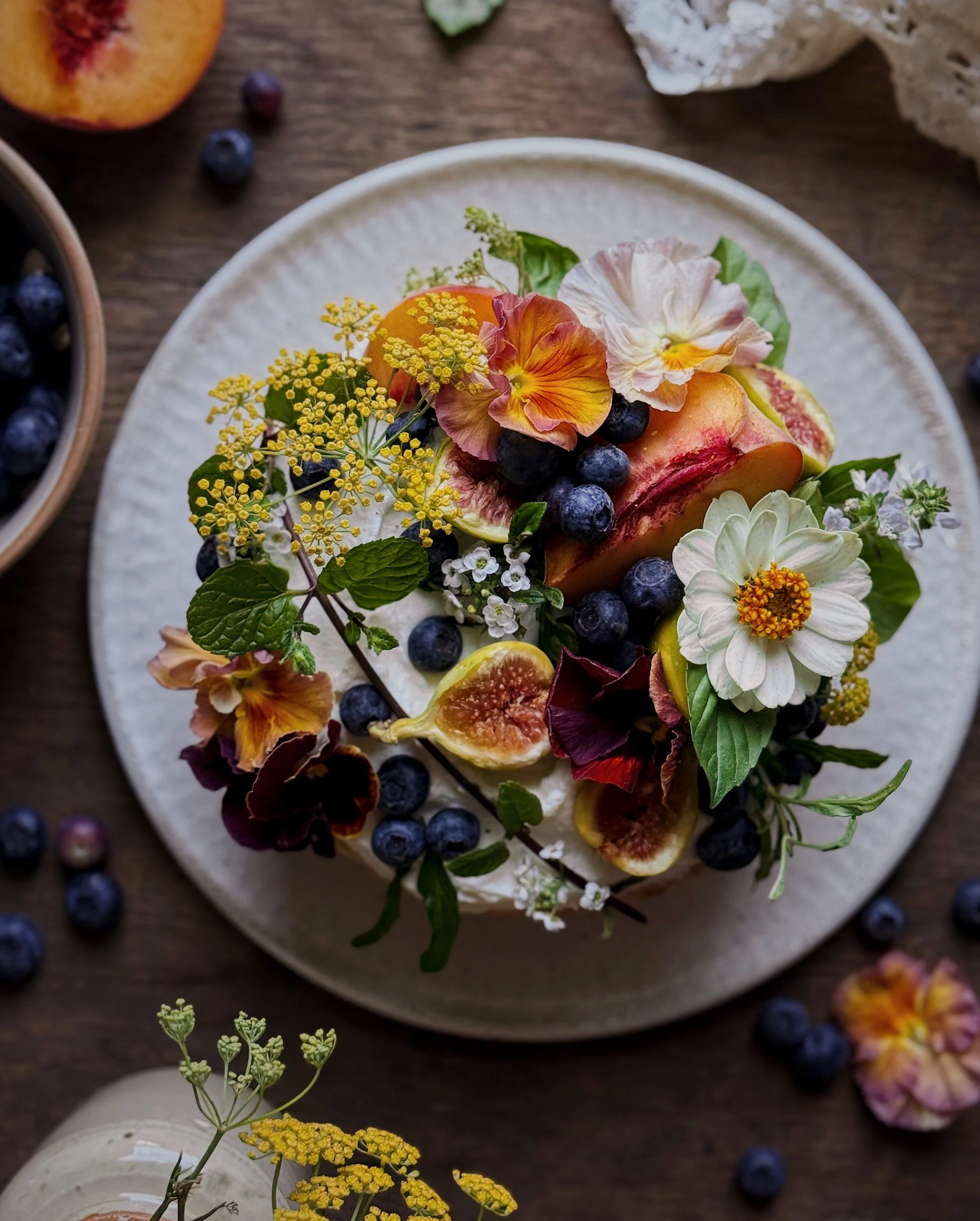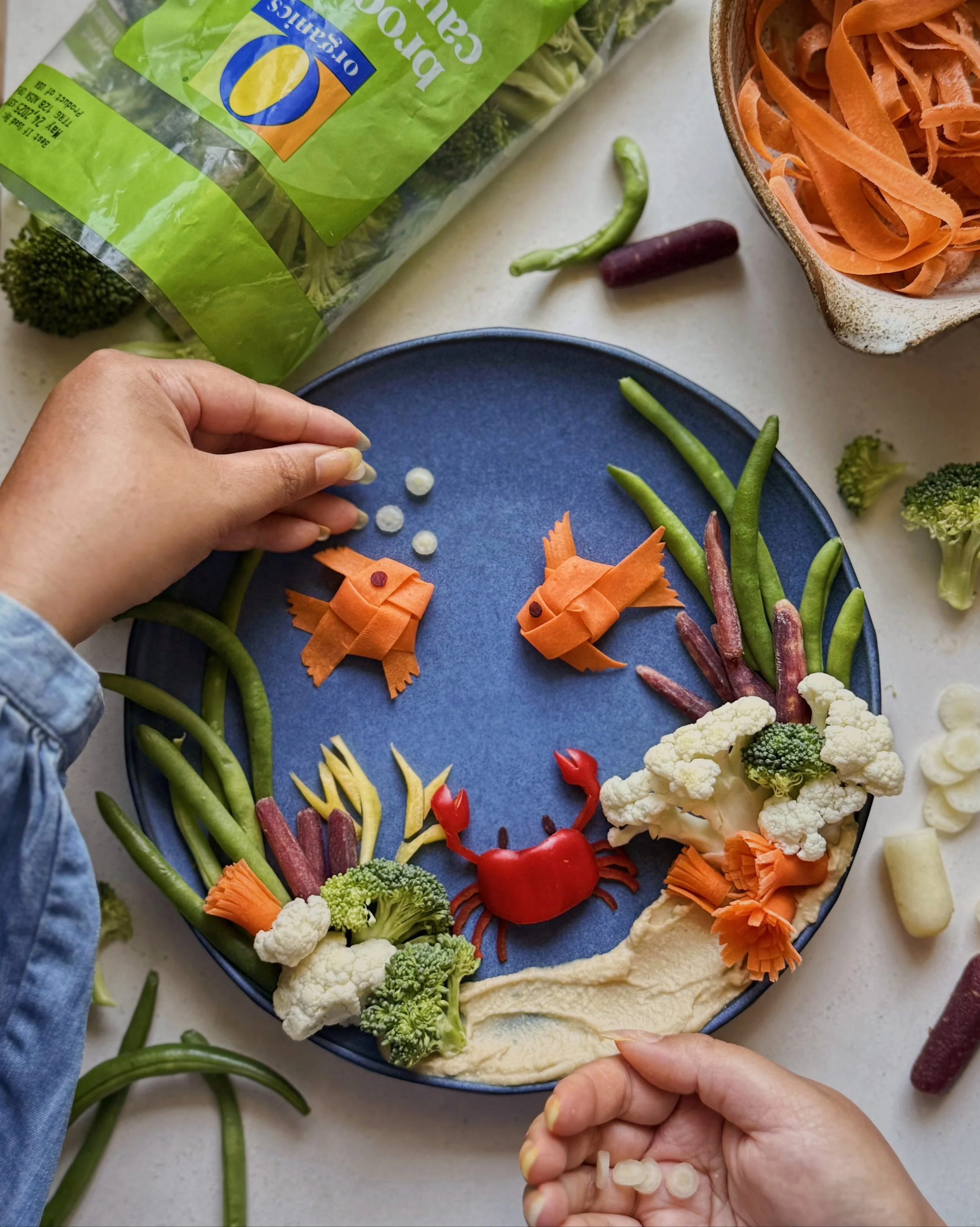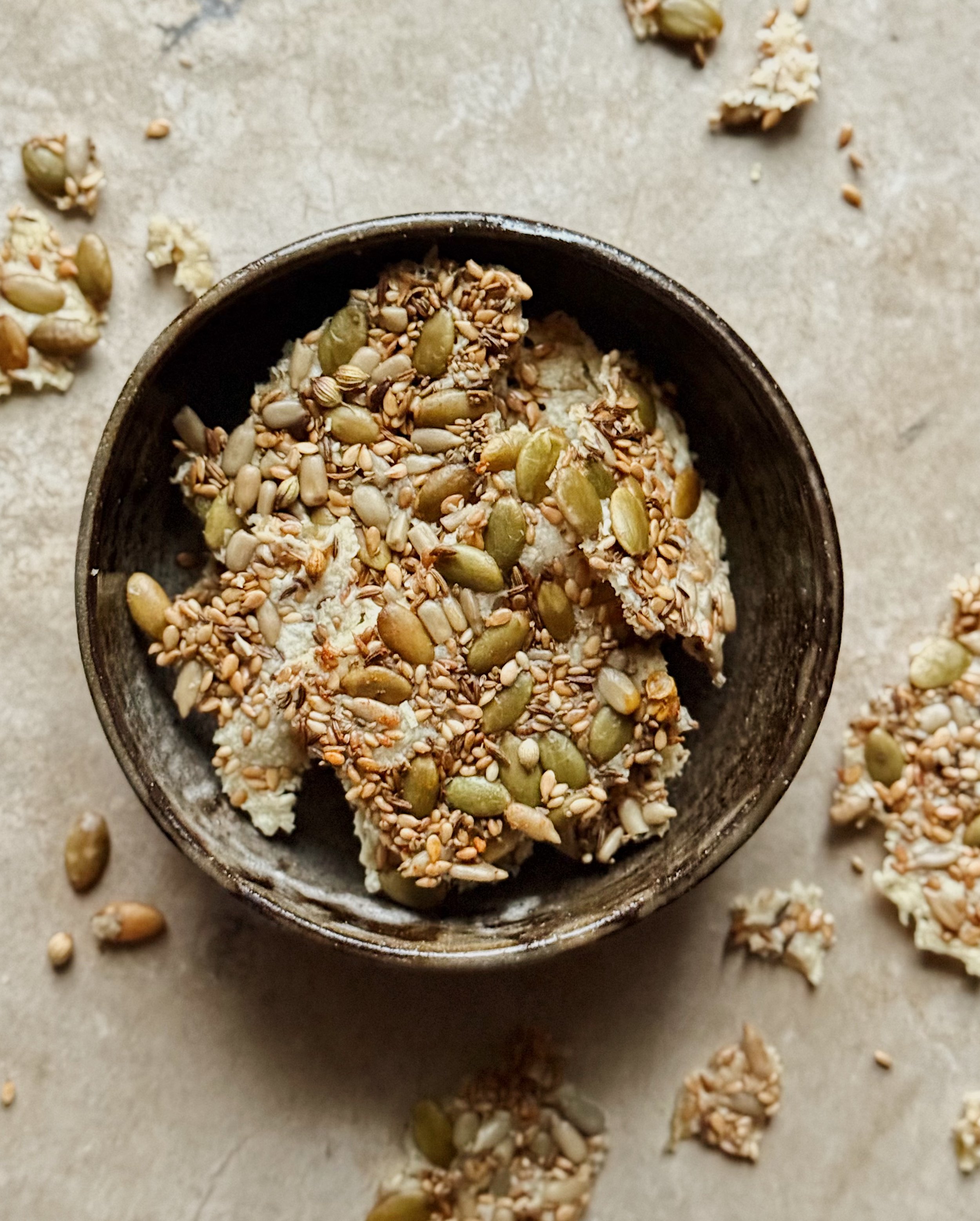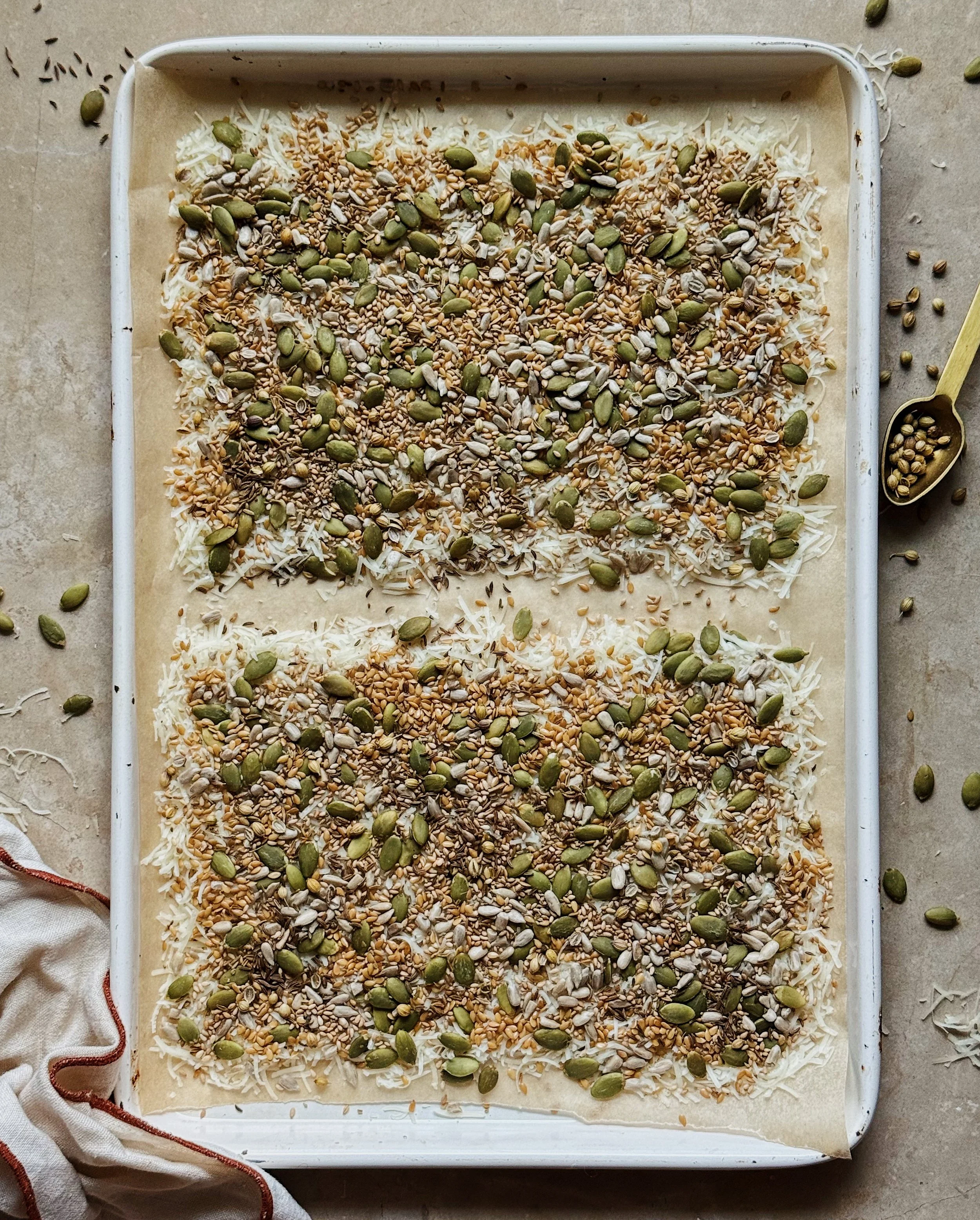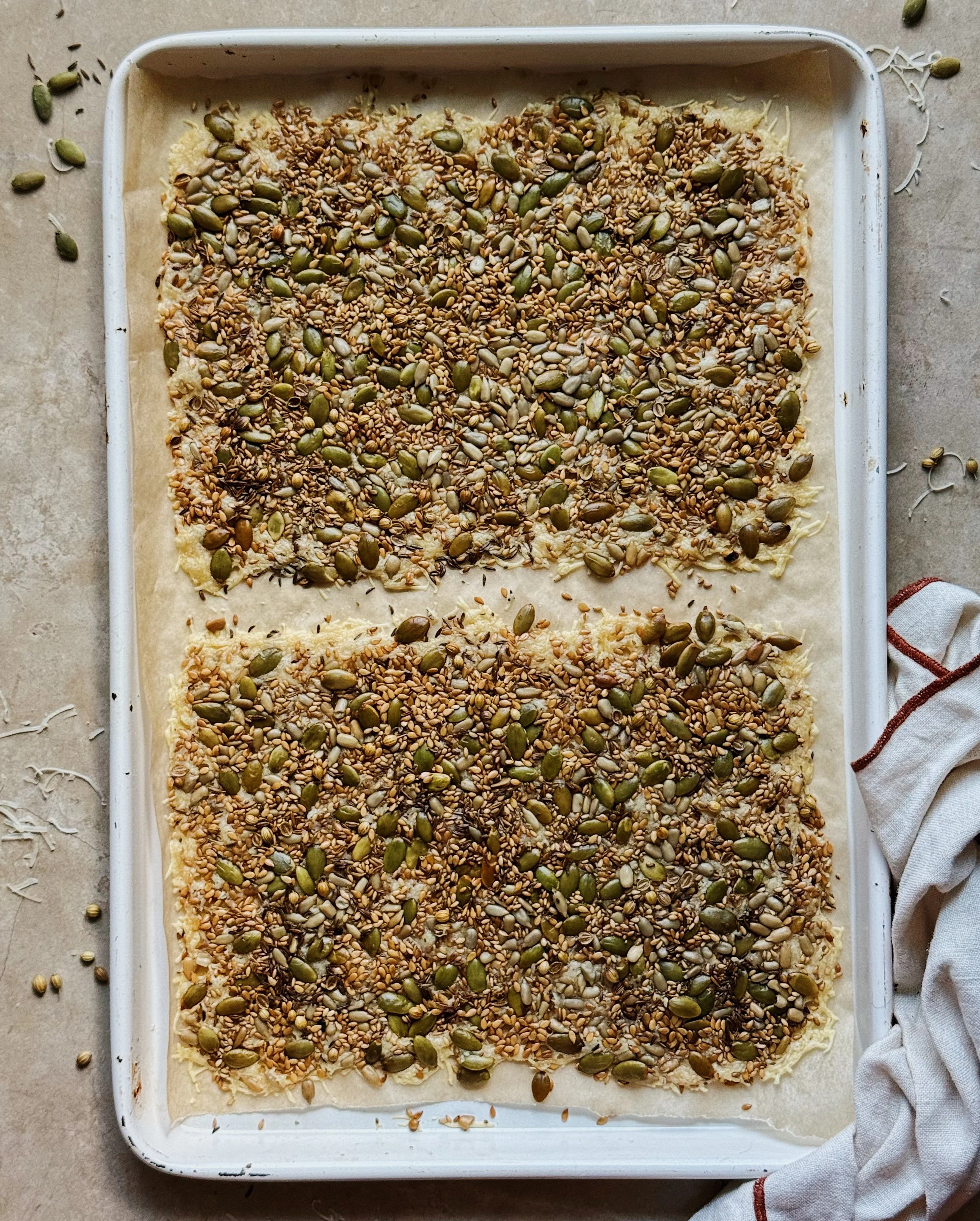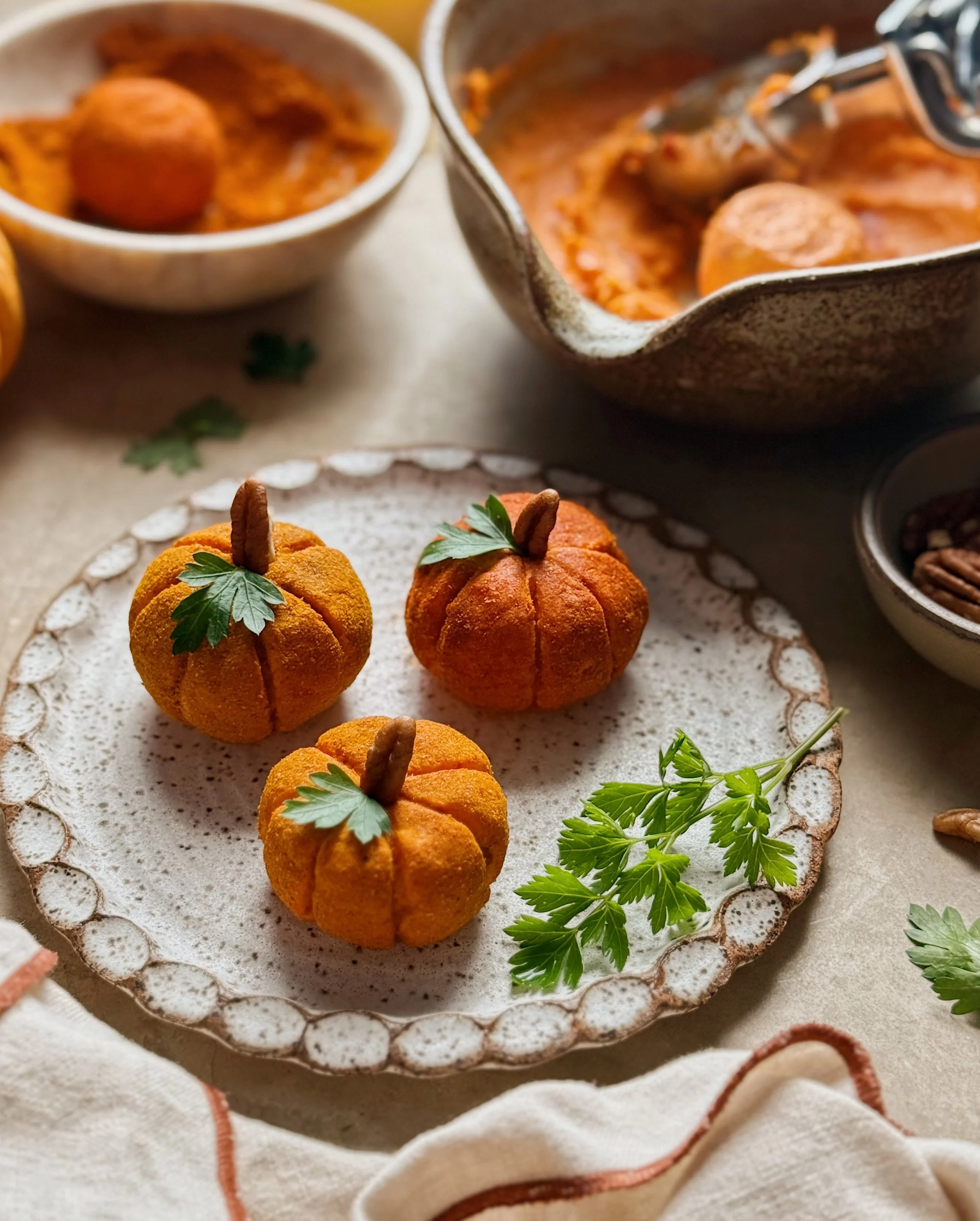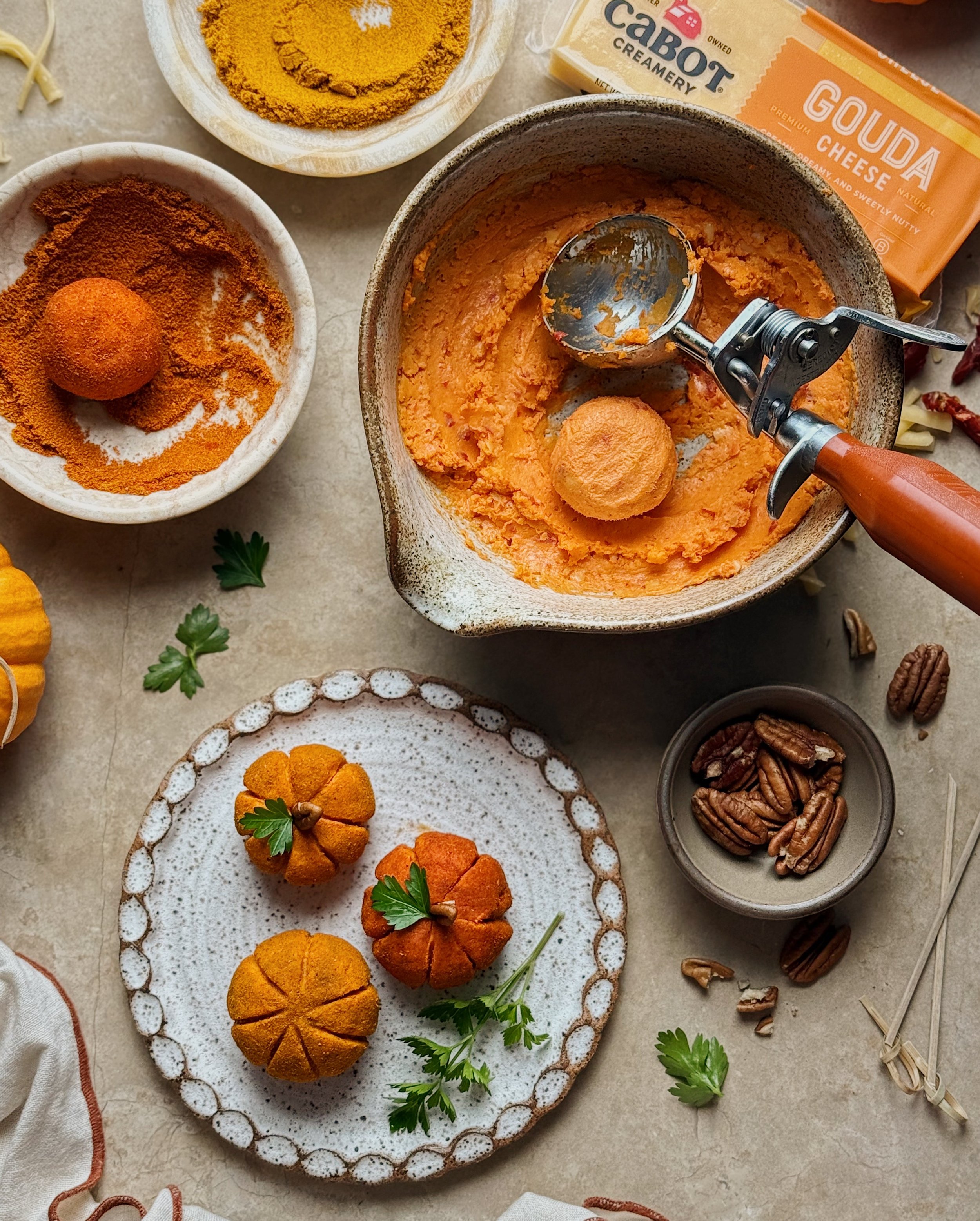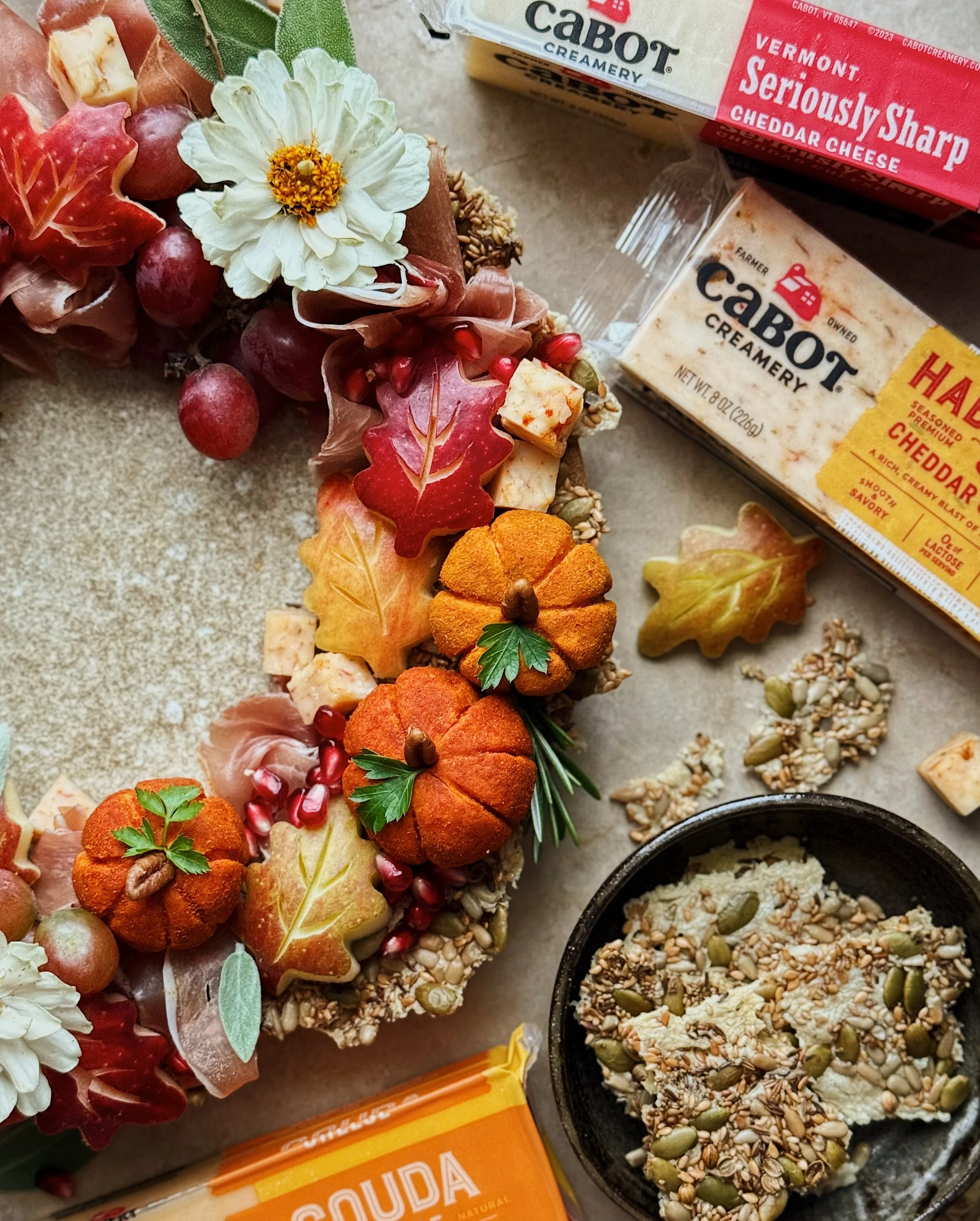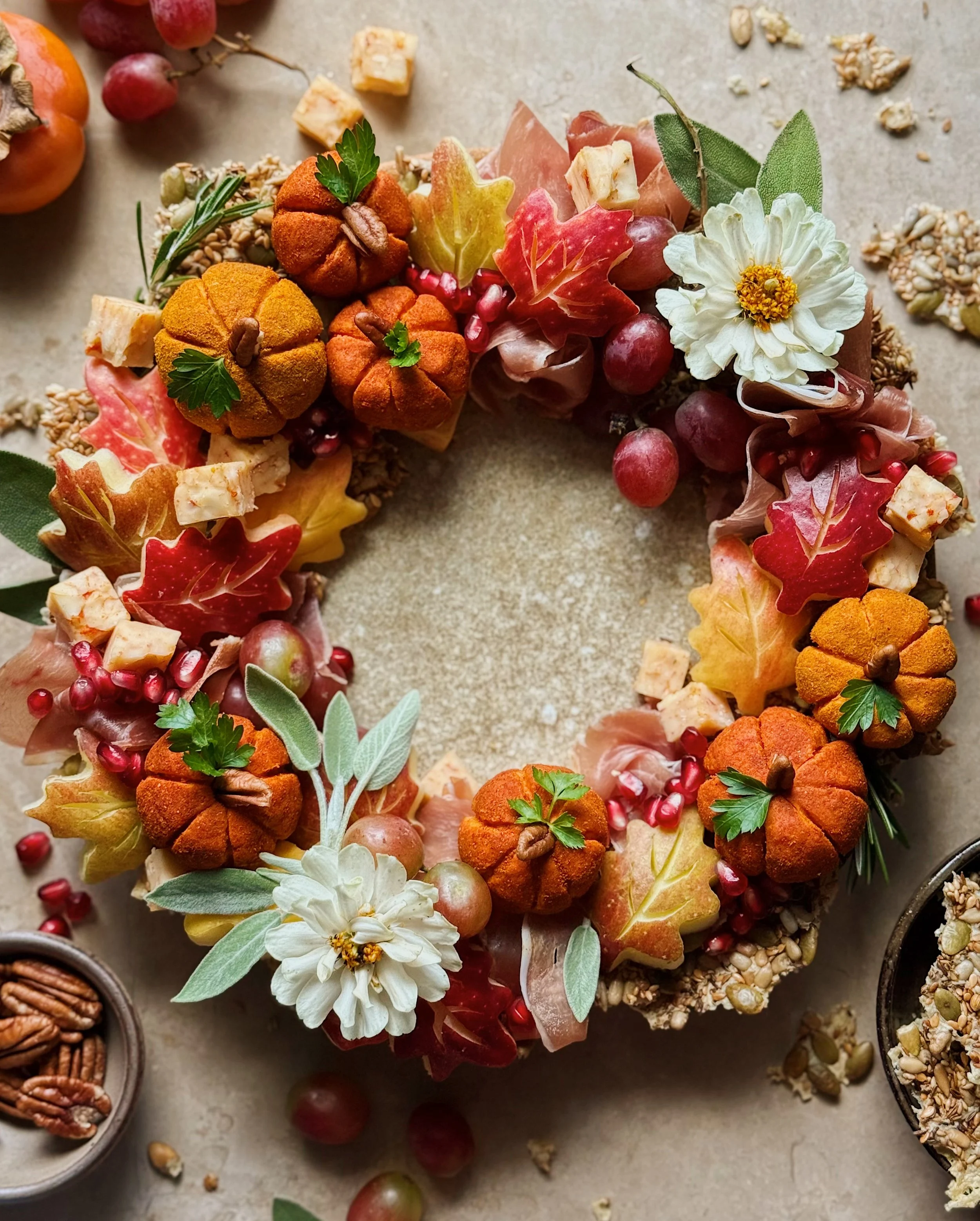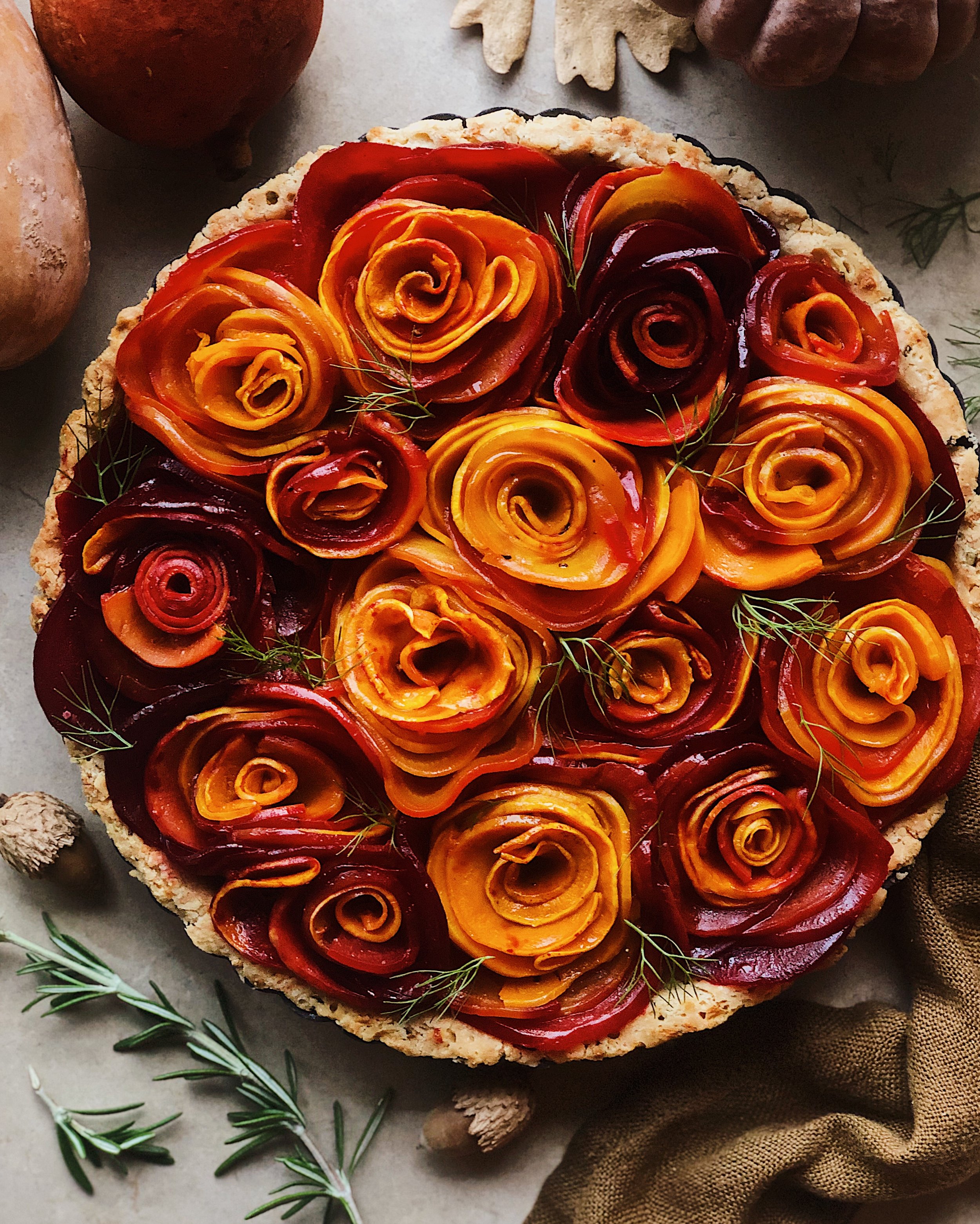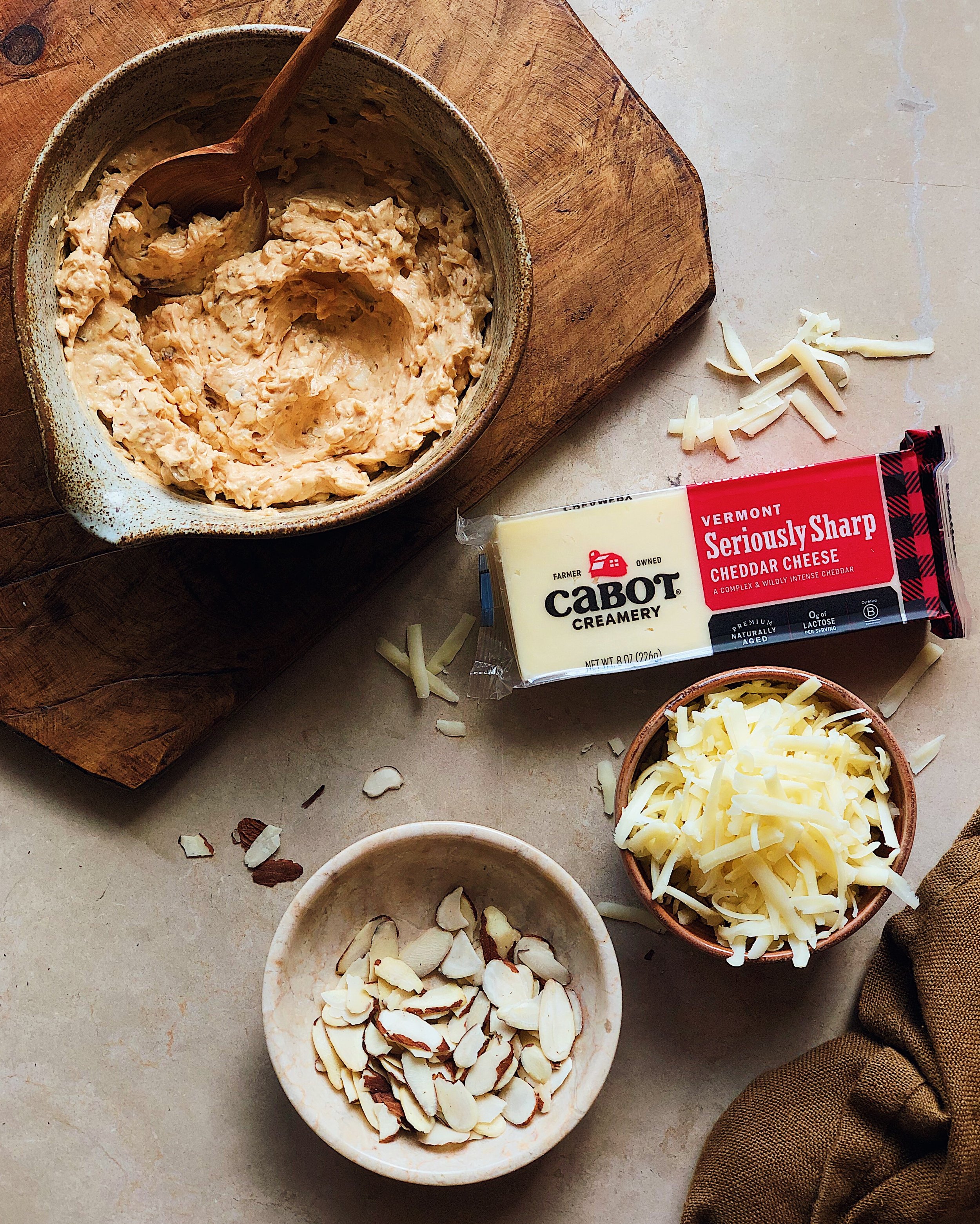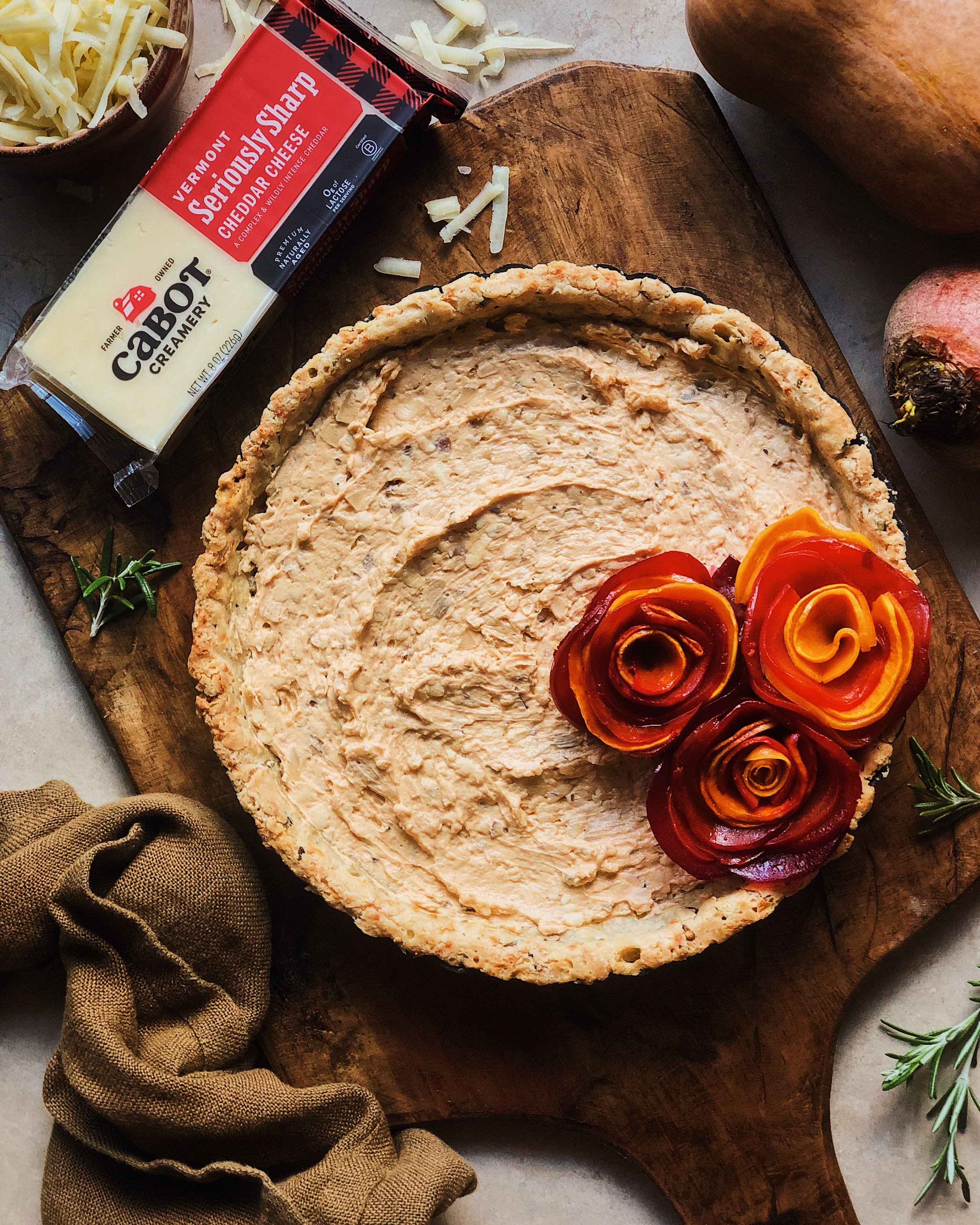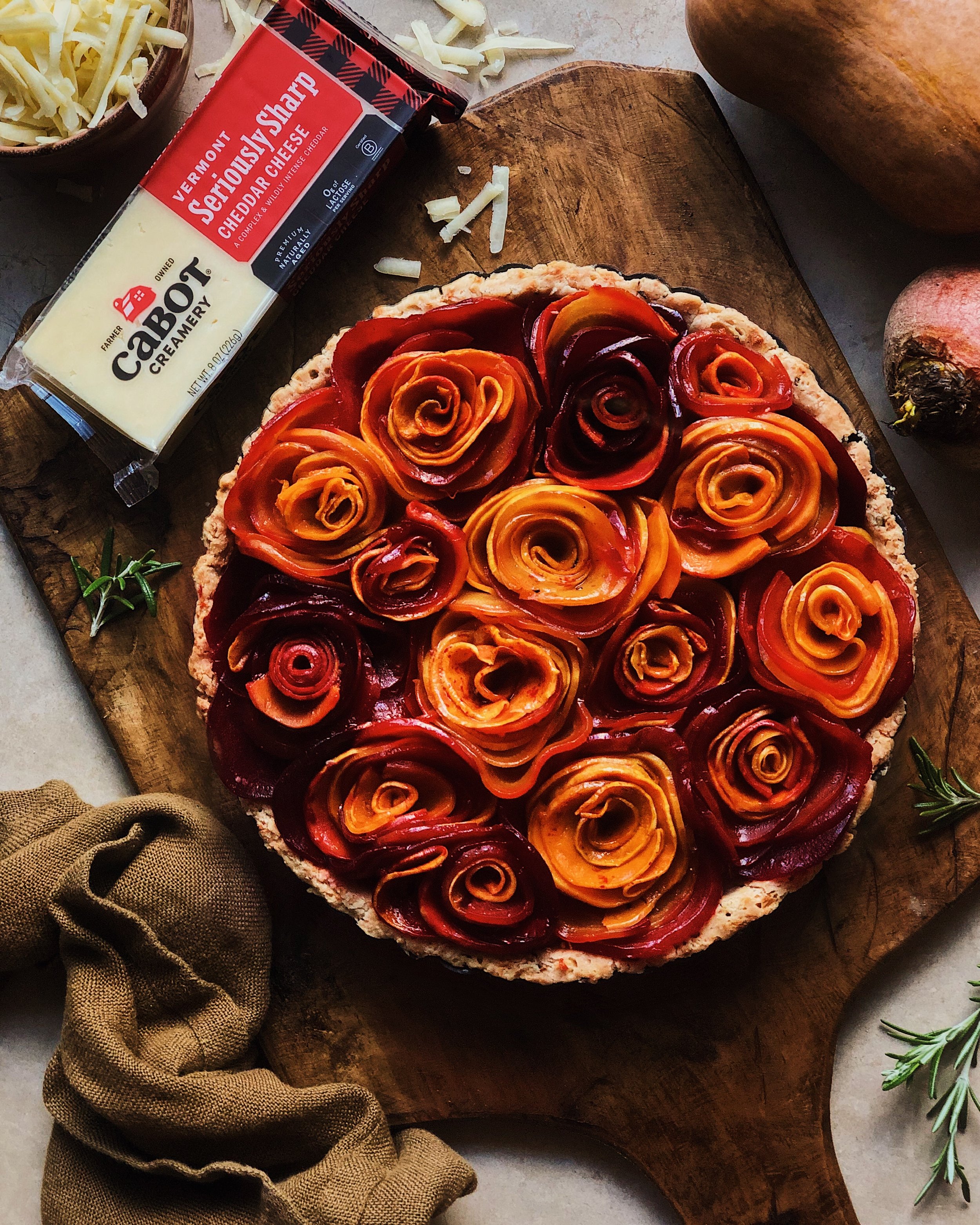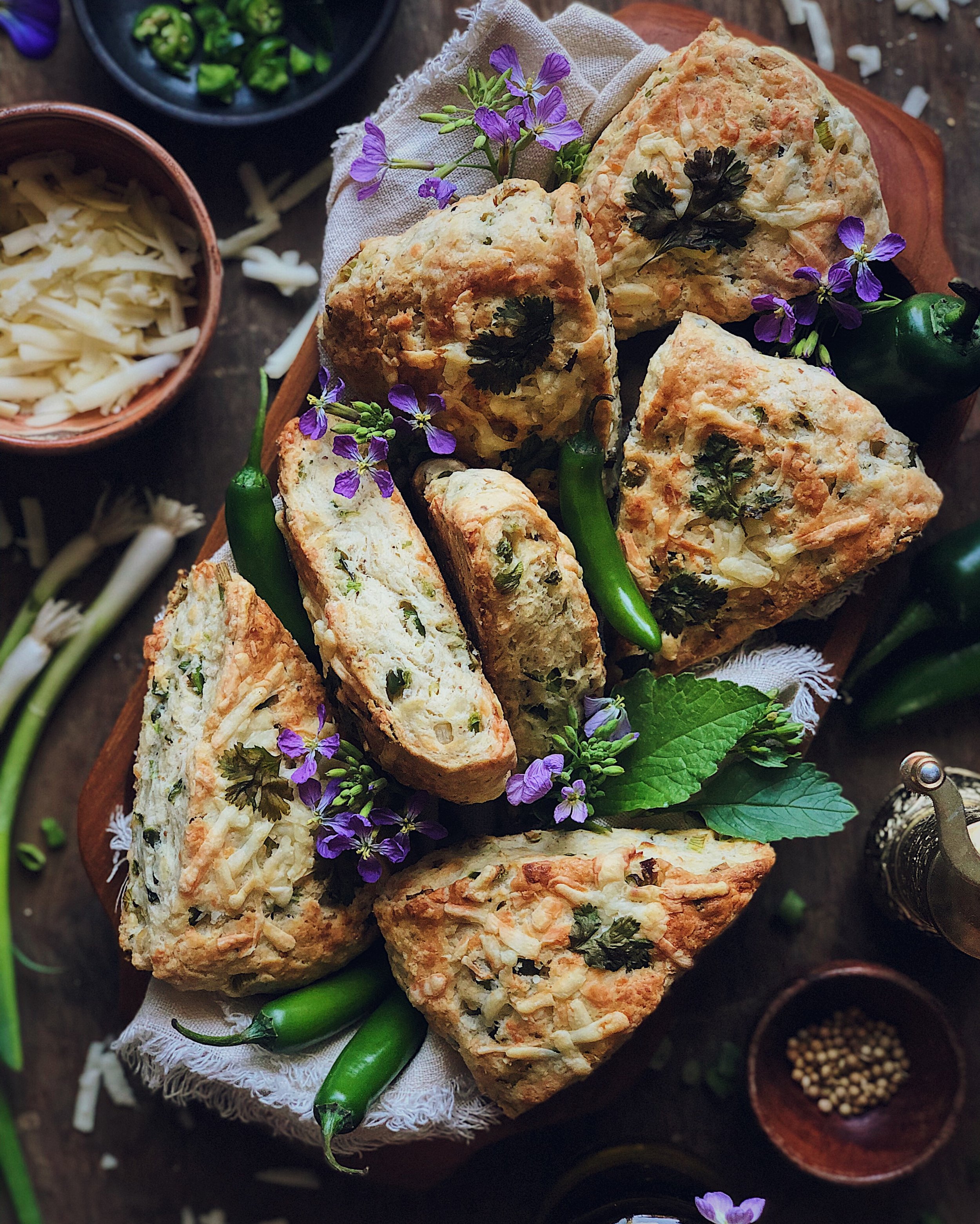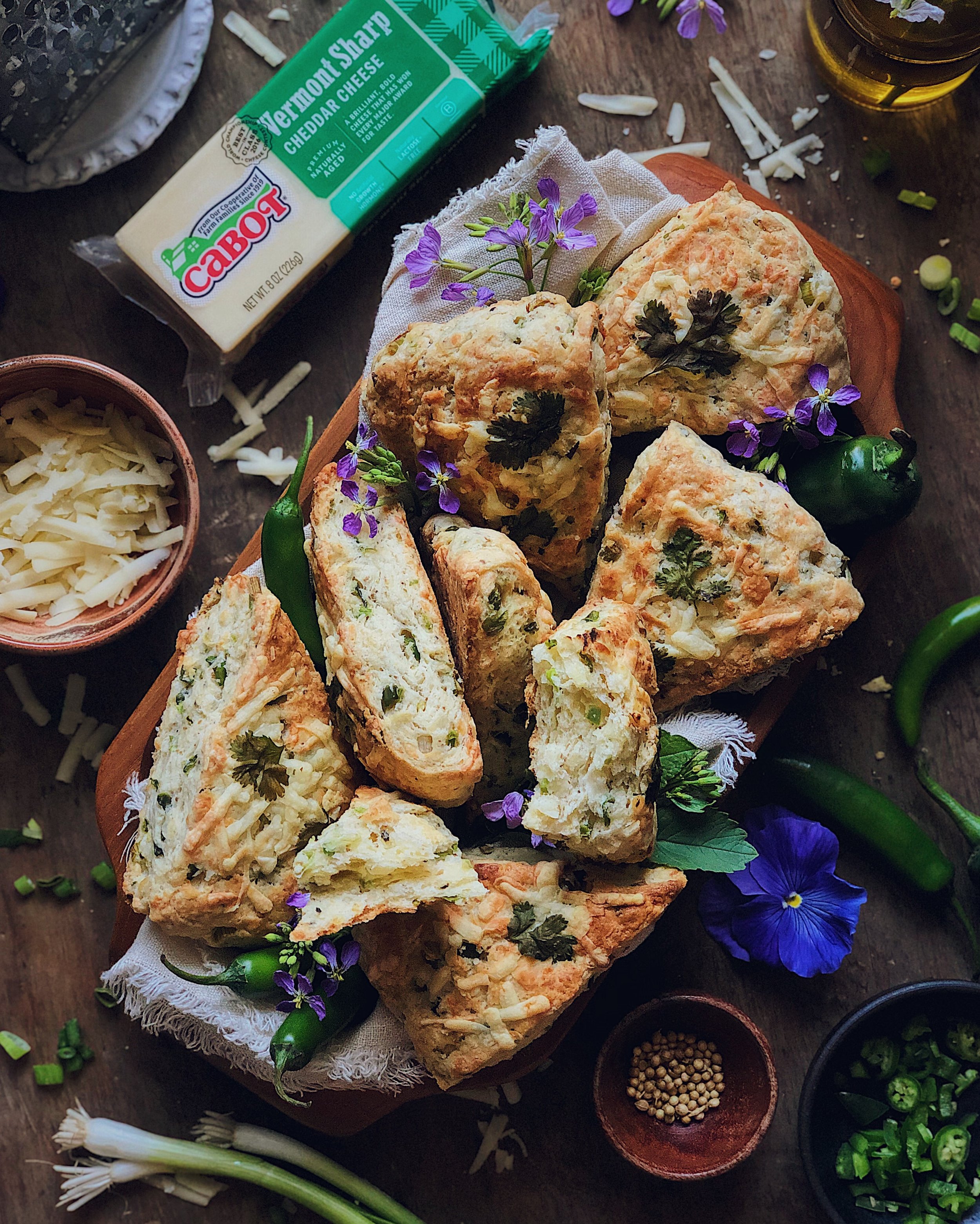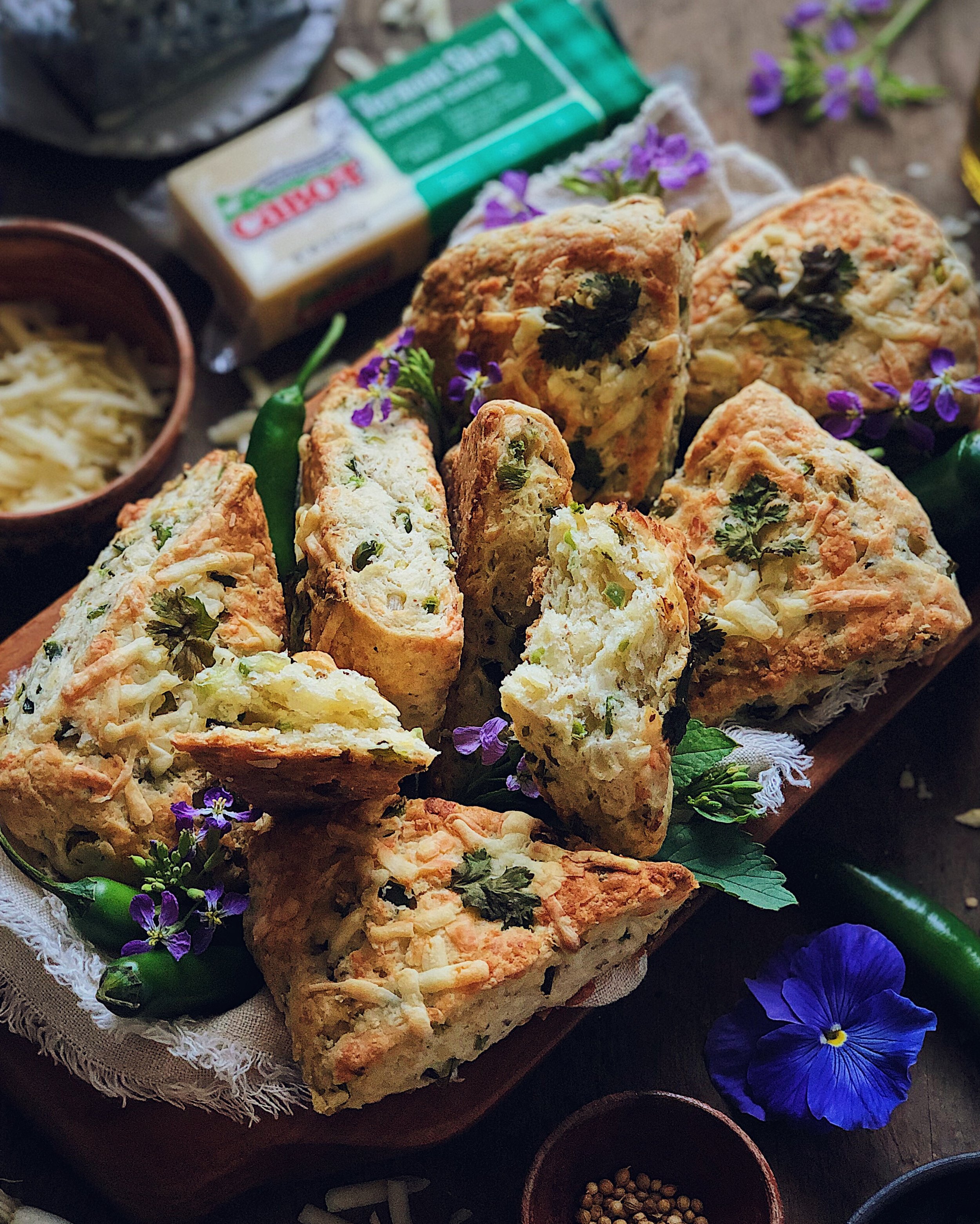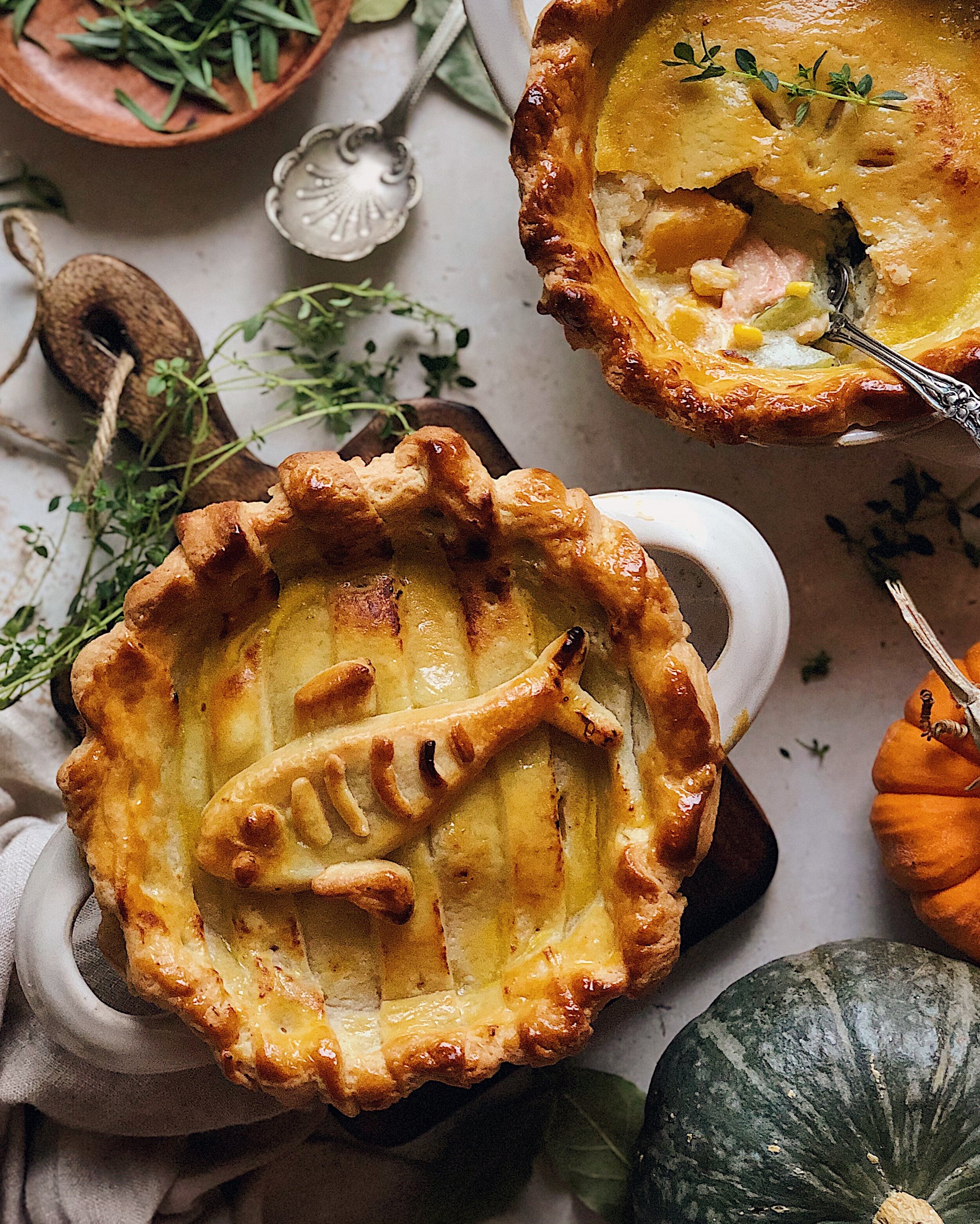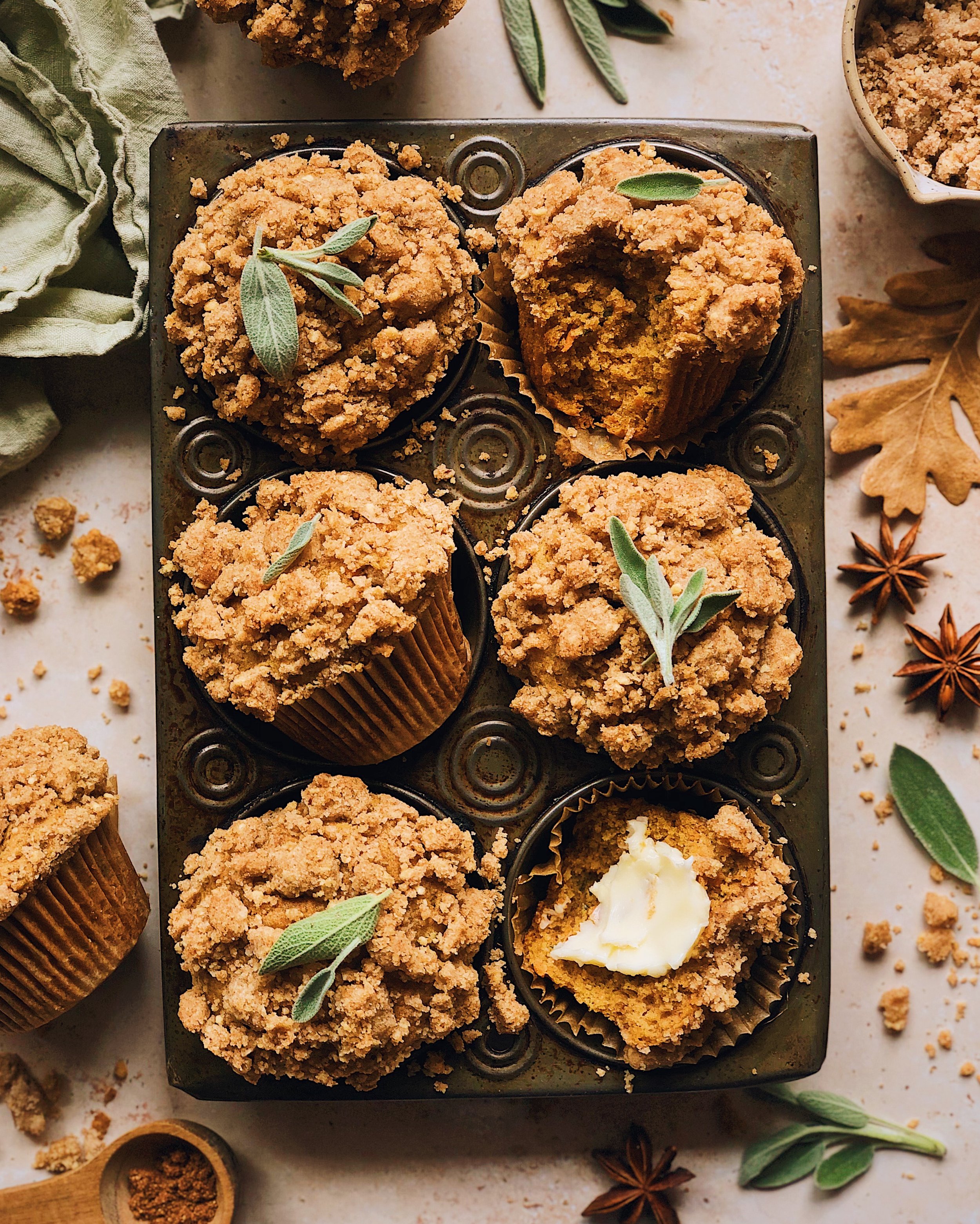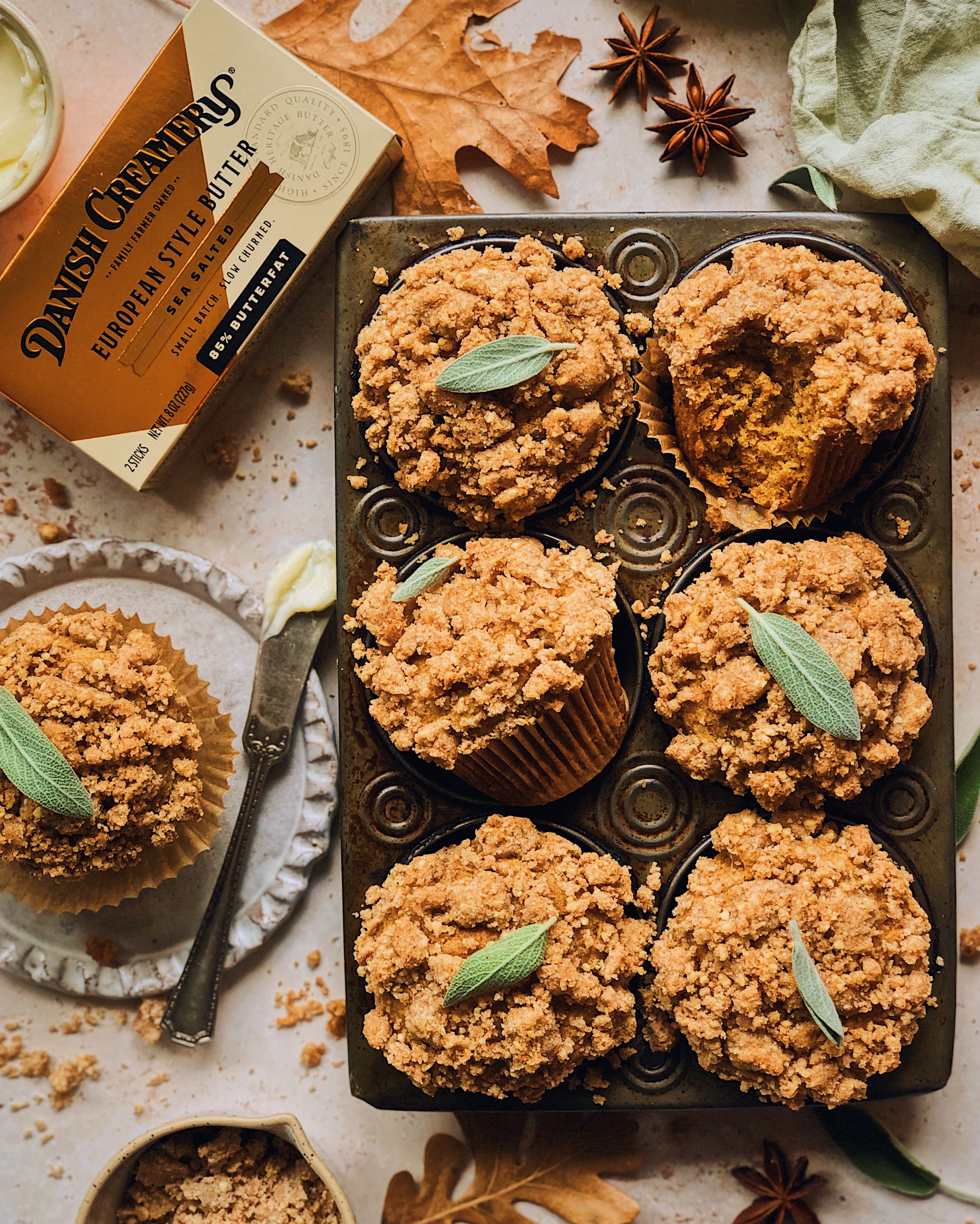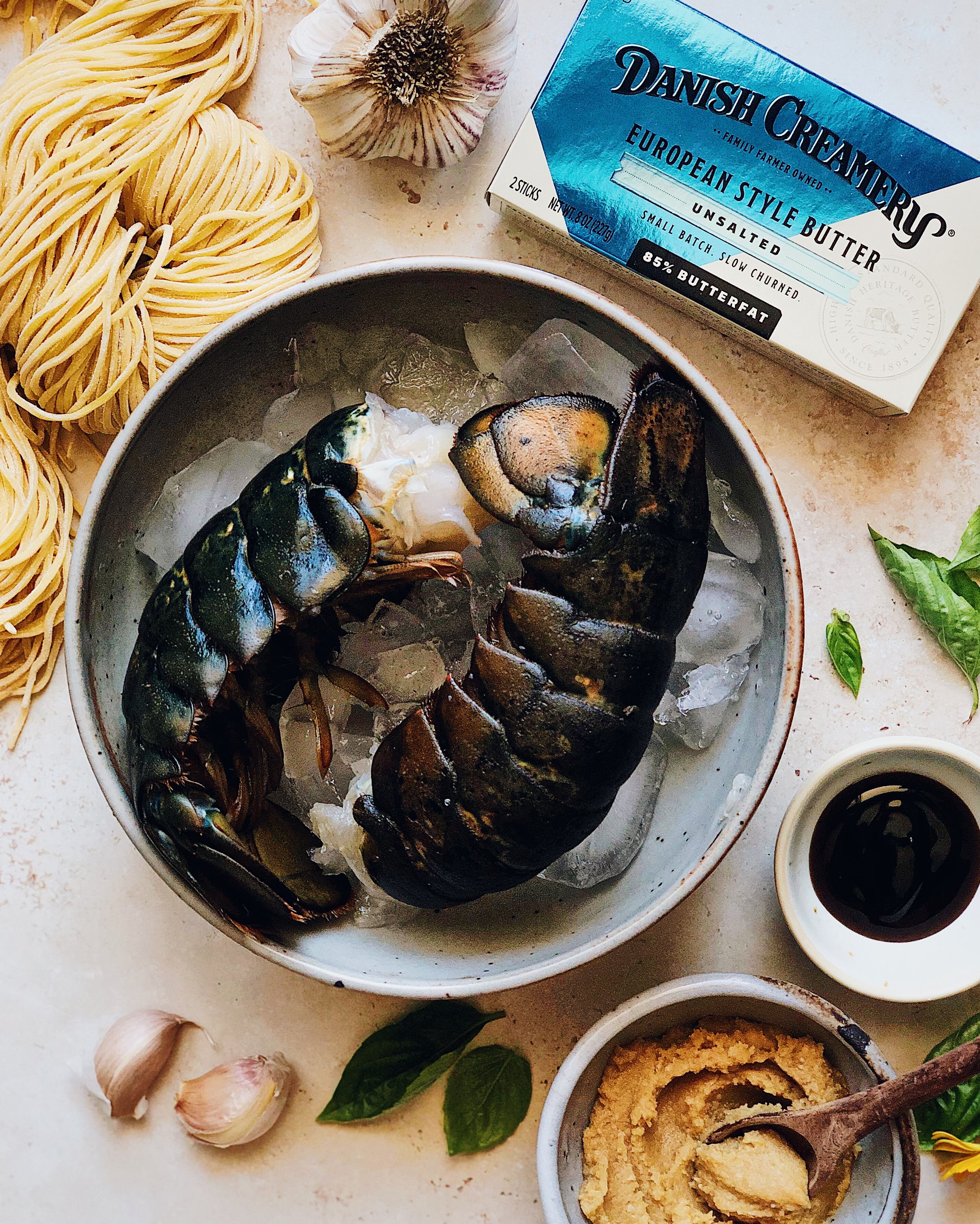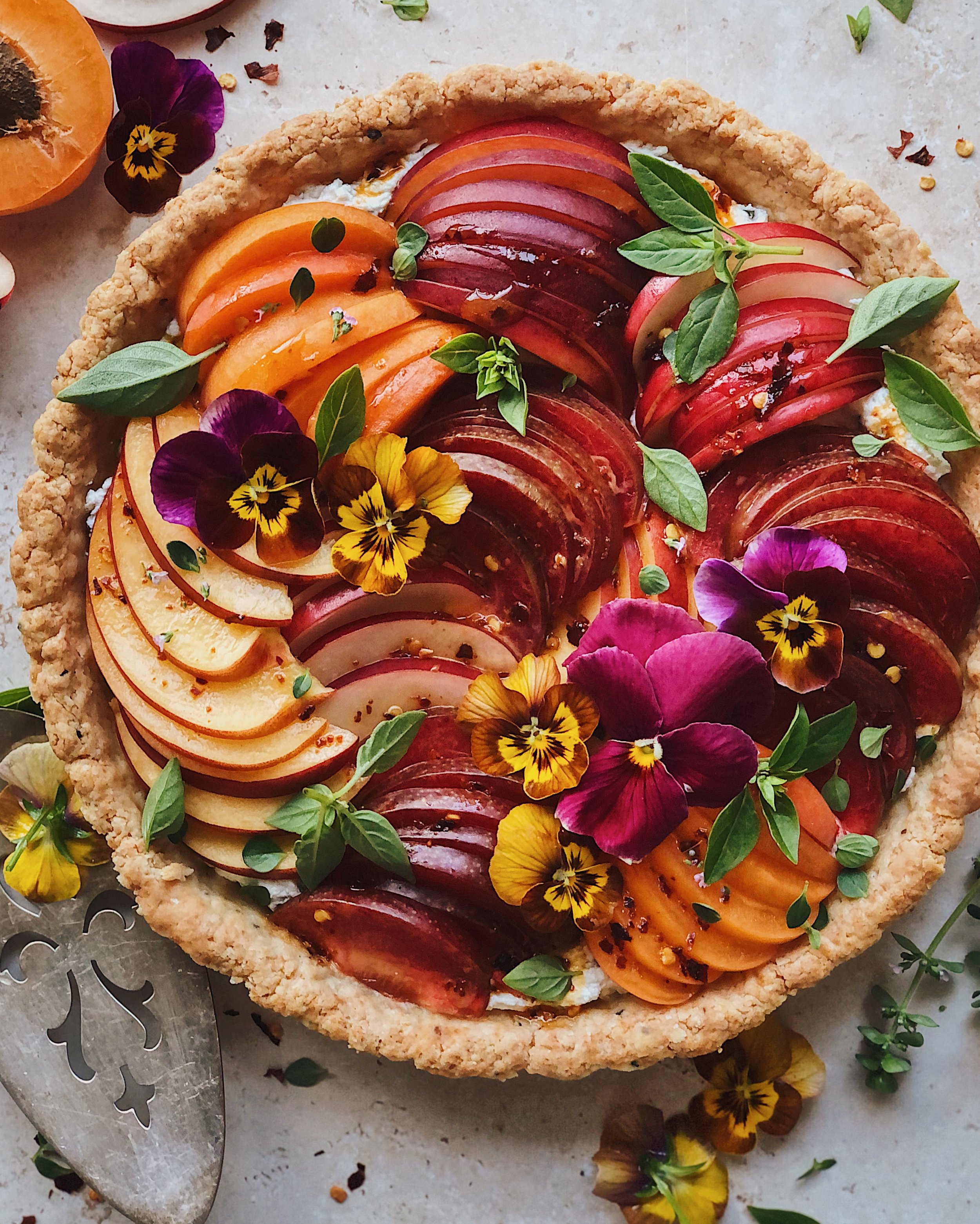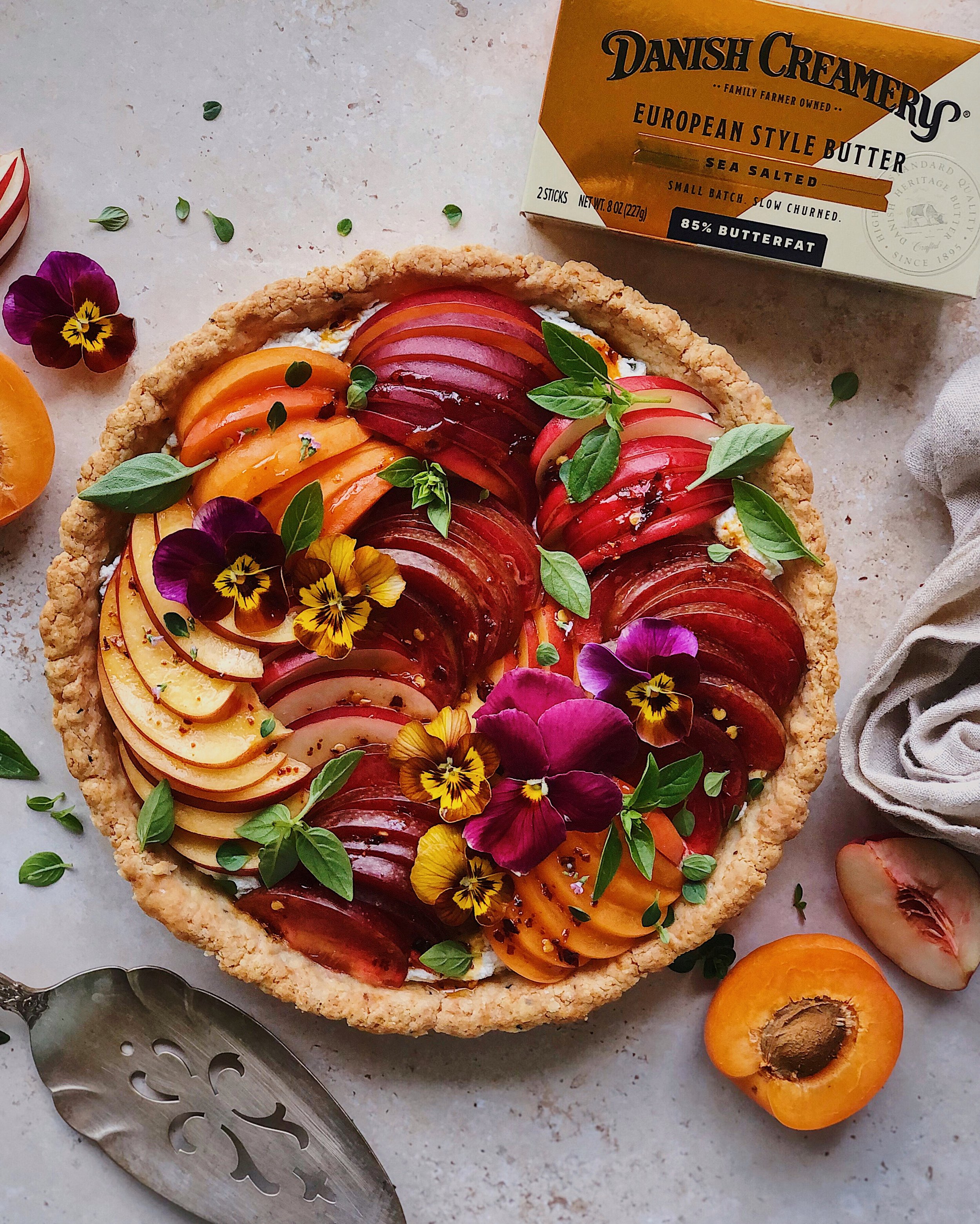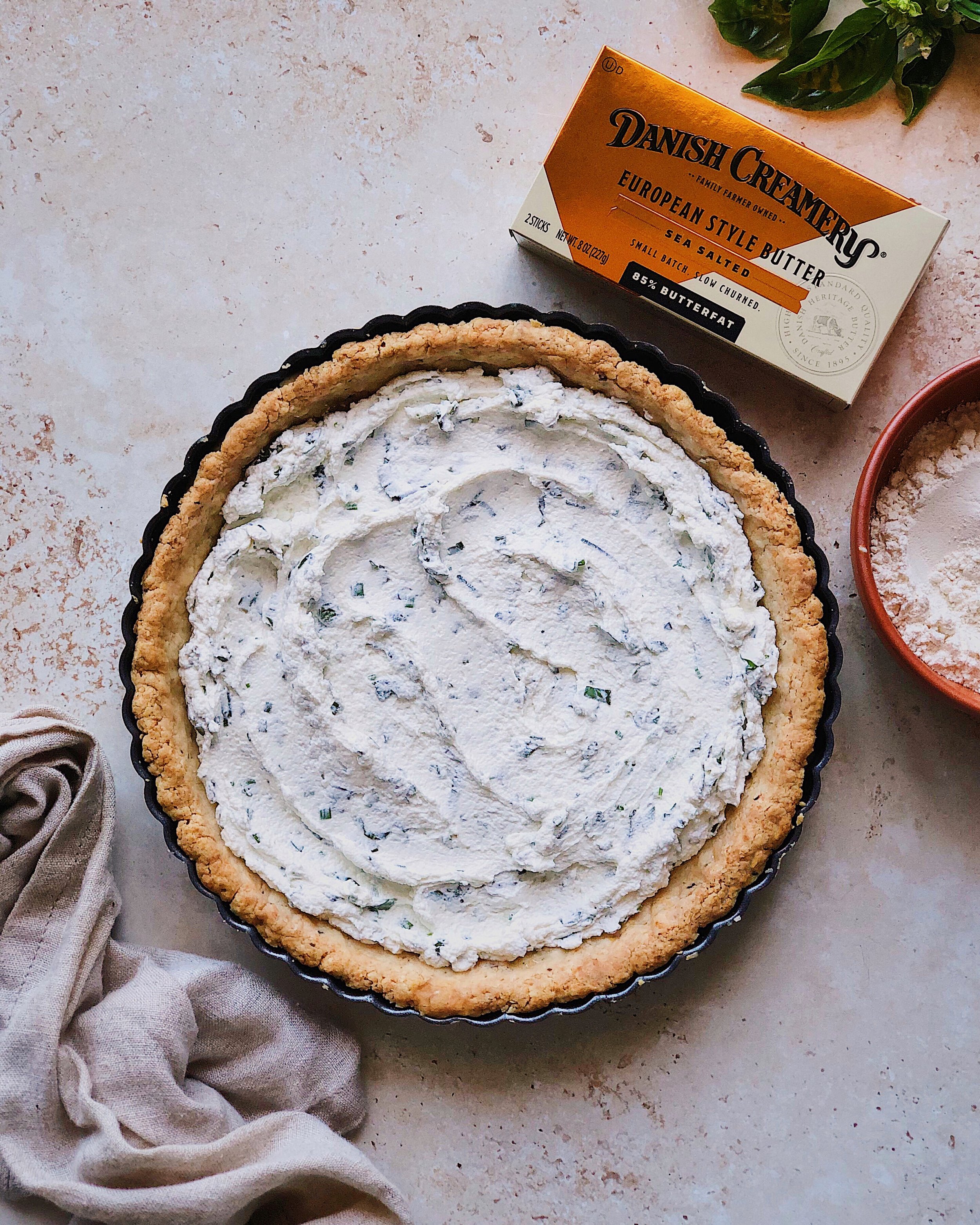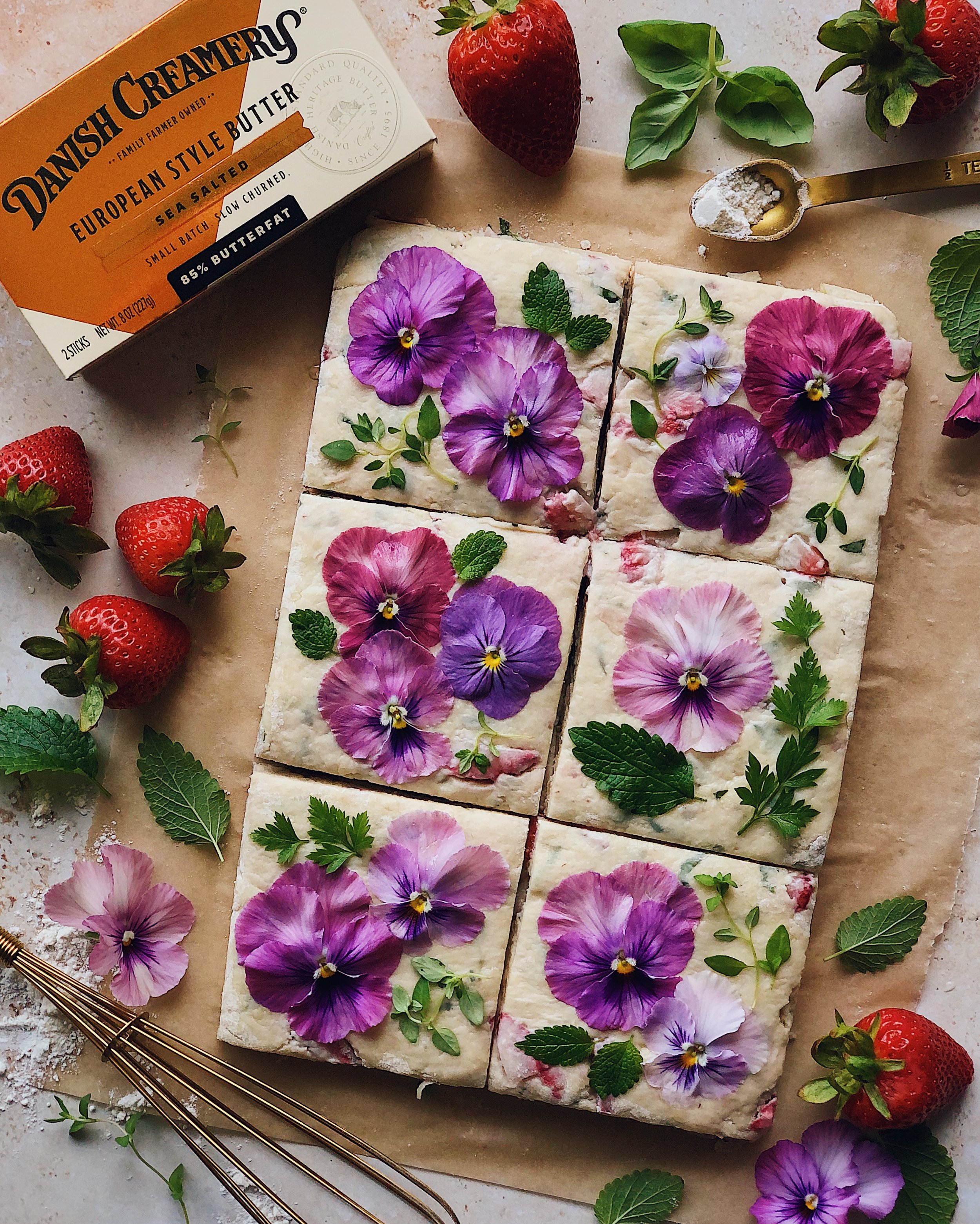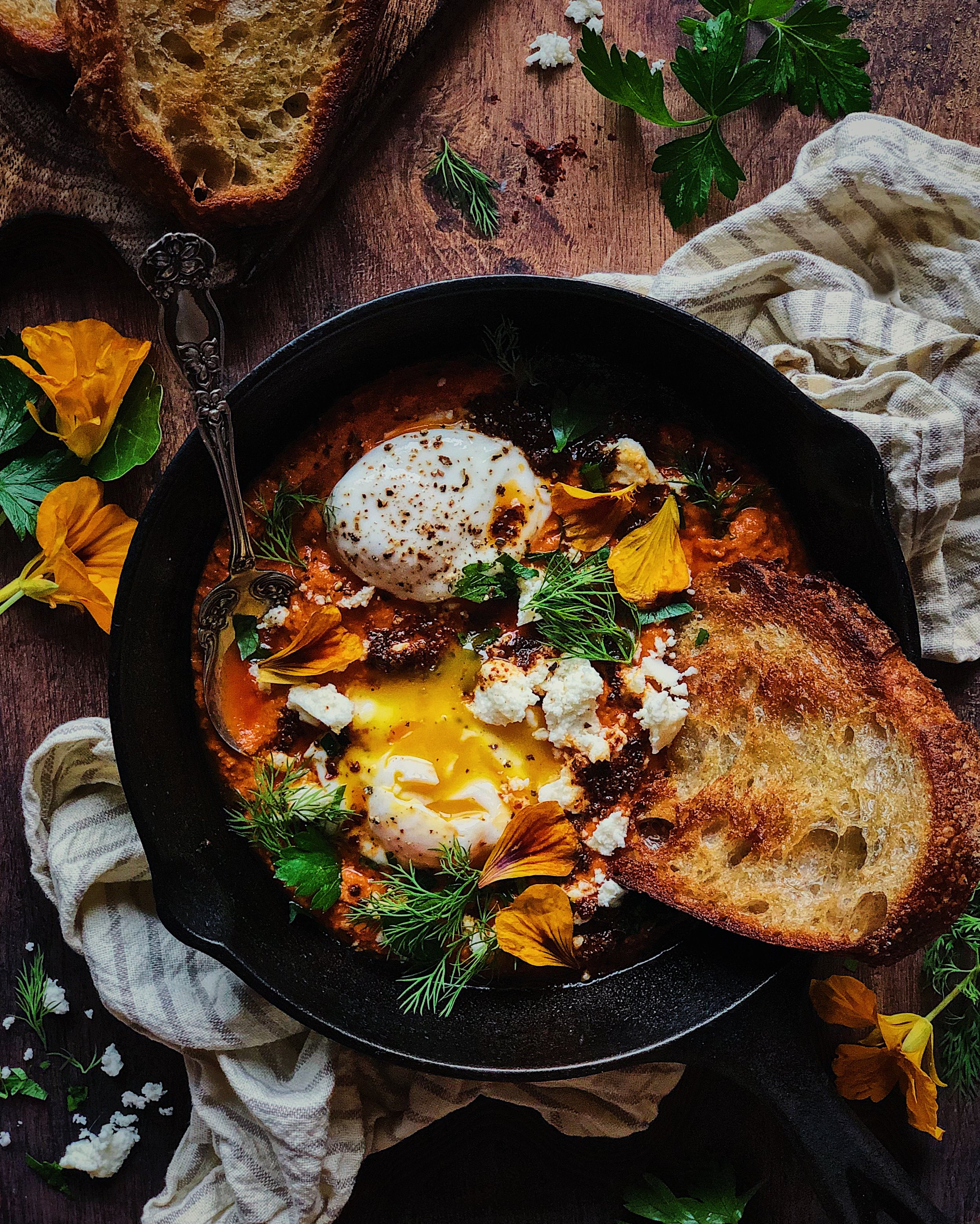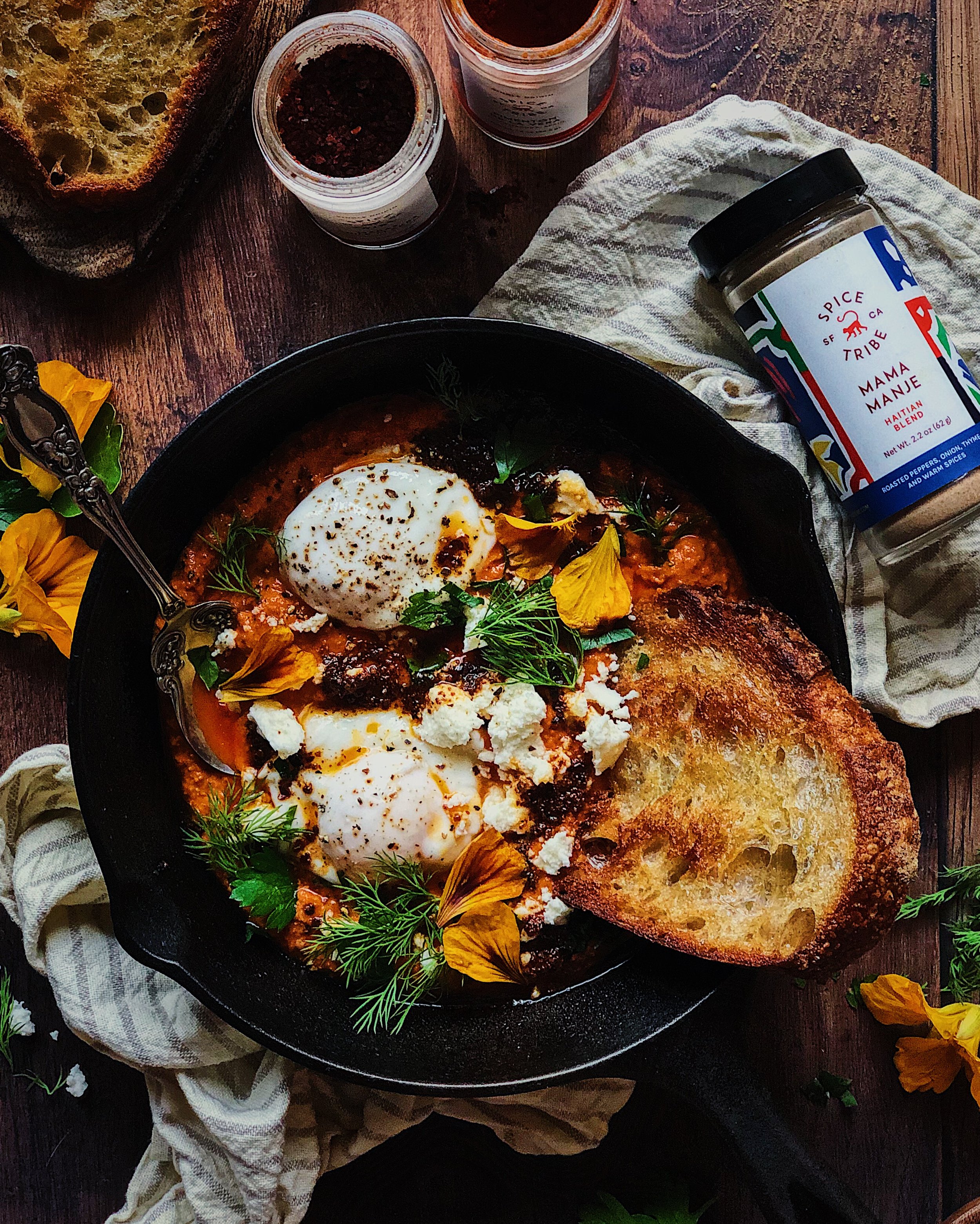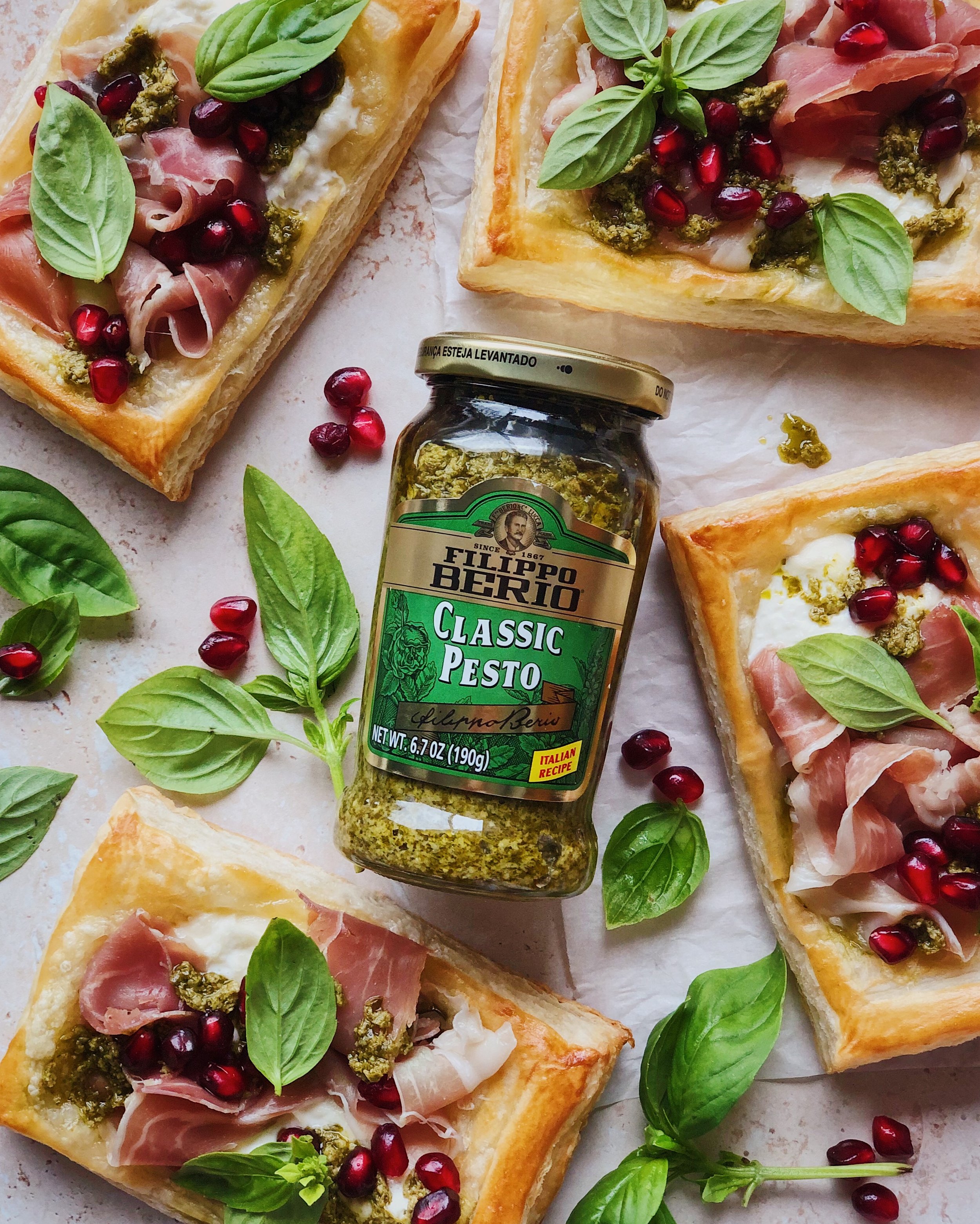Recipe: Fall Charcuterwreath with Homemade Cheddar Seed Crackers and Pumpkin-Shaped Sun-Dried Tomato Cheese Balls
/Lately, I have been really into making edible snacking wreaths because they combine my loves of food styling, arts and crafts, and eating cheese. So for this post, I partnered with Cabot Creamery to create a fall-themed charcuterie wreath (a charcuterwreath!) that incorporates their awesome cheeses in three different ways: homemade cheddar and seed crackers that are a dream for lovers of savory crunchy snacks, sun-dried tomato and gouda balls sculpted into adorable mini pumpkins, and cubes of their habanero cheddar to add a fiery kick of spiciness to the platter.
A pretty wreath is not just for Christmas time and I think that a pretty autumnal charcuterwreath is an easy win for if you are trying to impress guests at a Thanksgiving/Friendsgiving gathering or if you are wanting to treat yourself to a cozy day of snacking at home when the weather is too crummy outside. Compared to a more typical charcuterie board arrangement, I like styling charcuterwreaths with all the different ingredients portioned out into individual bites and scattered around in the circle so everything can easily be grabbed off and enjoyed (and there’s no awkward fiddling with the communal cheese knives while trapped making small talk at the snack table).
Personally, I’m always reaching for the cheesy bits of the nibble board and this post will go into detail about ways to use Cabot Creamery cheese to add a couple of homemade touches that will make the edible wreath extra special and tasty.
Cheddar Seed Crackers
These homemade crackers, loaded with tons of crunchy texture from a medley of different seeds, yet beautifully delicate from their base of finely grated cheddar, are so very addictive if you’re someone like me who is always going to reach for a savory snack over a sweet dessert. I could not stop eating them while I was recipe testing. Fortunately, they are super easy to make! I never thought I’d be making my own crackers from scratch as I hate rolling out thin dough, but this cracker recipe keeps my rolling pin at the bottom of its kitchen drawer and keeps me happily munching.
Notes about the ingredients for the Cheddar Seed Crackers
Sharp Cheddar: Finely grated Cabot Seriously Sharp Cheddar serves as the base for the crackers. When spread out thinly and baked, the cheese crisps up into something delicate, lacy, and tasty on its own but even better loaded up with different crunchy seeds. I love that the tang of the sharp cheddar still permeates every bite no matter how many different kinds of seeds I crammed onto the surface.
Cornstarch: I found that mixing the grated cheese with a tiny bit of cornstarch really helped with making the base of the crackers light and crispy instead of chewy.
Mixed Seeds: Using a medley of different seeds is what makes these crackers look so exciting. I used pepitas, sunflower seeds, sesame, golden flax, cumin, coriander, carraway, and celery seeds. Some of these, like the pepitas, sunflower, and flax add textural interest to the crackers, while the coriander, cumin, and caraway seeds bring wonderful flavor complexity to the mix. I have included the measurements that worked well for my household’s tastes in the written recipe below, but you can certainly adjust the proportions based on your preferences. I recommend using plain, raw versions of these seeds as they will get adequately roasted in the oven as the crackers bake.
Helpful tips and notes about making the Cheddar Seed Crackers
Be sure to use a cheese grater with smaller holes to finely grate the cheese bar.
For this recipe, you’ll be baking sheets of crackers and then breaking them up into rustic smaller bites. I think this adds to the autumnal theme as each cracker is unique and crunchy, like fall leaves on the ground! I found that spreading the cheese into thin 9” x 6” rectangles on parchment paper allowed them to transform into evenly crispy crackers without a particularly long bake time. If you wish to bake everything as one big sheet across the whole baking pan for ease, note that the center may not turn out as crispy as the outer areas.
You can make these a couple of days ahead and store them in an air-tight container.
As a bonus, these homemade crackers are gluten free! And all of Cabot Creamery’s cheeses contain 0g of lactose per serving, so you can feel good about sharing these even with those Friendsgiving guests who have sensitive tummies.
Pumpkin-Shaped Sundried-Tomato Cheese Balls
The mini pumpkins that you see on my charcuterwreath are actually made of cheese! The filling is so easy for these as well; just throw everything in the food processor. Using a skewer or toothpick to create indentations in the balls is enough to give them that pumpkin shape, and then how much effort you want to put into refining that look is up to you, but it’s well worth it because I think these are what really make the wreath give those fall vibes.
Notes about the key ingredients for the Pumpkin-Shaped Sundried-Tomato Cheese Balls
Cream Cheese: This is what acts as the binder. Processing the other ingredients to break them down and combine them with the cream cheese will render a mixture that is easy to shape and sculpt into cute mini pumpkins.
Gouda: Creamy, nutty Cabot Gouda adds a nice mild cheese flavor that pairs so well with the sun-dried tomatoes.
Sun-Dried Tomatoes: These add a brightness and a hint of tartness that makes these cheese balls so snackable. Look for the dry-packed sun-dried tomatoes, not the ones packed in jars of oil.
Spices for Coating: I used a mild curry powder and paprika to give these mini cheese ball pumpkins their earthy orange colors. For the richer orange color, I used equal parts of curry powder and paprika and whisked them together. For the less saturated orange shade, I used just curry powder. I found that the flavors of these spice blends complemented the filling very well. Feel free to experiment with other spice blends to get the colors you desire. While the filling is already orange, I would not recommend serving the cheese balls uncoated as they will be more sticky to pick up without the thin layer of dried spice powder.
Pecans: I used pecan halves split lengthwise (therefore pecan quarters) to be the “stems” for the pumpkins. Pieces of walnuts, pretzel sticks, or pepitas would work well here too.
Parsley: I used parsley for the leaves of these mini pumpkins but you could use whatever small leafy herb you wish. Personally, I think that parsley and cilantro leaves are what best resemble real pumpkin leaves on the vine.
Helpful tips and notes about making the Pumpkin-Shaped Sundried-Tomato Cheese Balls
Chill the mixture until it’s firm to make it easy to work with. For best results, I recommend making the filling a day ahead but doing the coating and shaping the day of. However, if you are trying to prep ahead as much as possible, you can do everything but adding the “stem” and the leaf in advance. The spice coating will simply have a more bled-in look if you go this route.
I recommend scooping and rolling 2-tablespoon balls for a nice grabbable portion; the written recipe below will yield about 15 of these. However, for the photos of the wreath I made slightly varying sizes for a more organic look.
Assembling the Fall Charcuterwreath
Just a couple of visually charming and delicious homemade elements will be enough to make your edible wreath an extraordinary centerpiece, so you can certainly fill the rest of it with typical charcuterie board ingredients that require little or no prep. I really don’t think this part of the process should require much measuring, but I will provide estimates of the quantities I used for the wreath in my photos in the recipe below. I used a 10-inch plate for mine, but obviously to get that abundant look, the quantities you need will vary based on the size of the serving board you choose. My main advice here is to be sure to choose good-quality ingredients that will do justice to your wonderful cheesy homemade creations and lean in to the autumnal theme by selecting a variety of flavors that celebrate the season.
Here’s a list of what I used to complete my wreath:
Habanero Cheddar: I cut up small cubes of Cabot Habanero Cheddar to bring something spicy to the board. I felt that of all of Cabot’s fantastic cheeses, this was the best to use as a stand-alone in my charcuterwreath because it packs such a punch of flavor and also happens to look so autumnal because of the flecks of habanero and jalapeno chili peppers. This is the boldest and spiciest cheese I’ve ever tried and if you like spicy foods like I do, you should definitely give this one a try too.
Prosciutto: It can’t be a charcuterwreath without some sort of cured meat, right? I chose prosciutto because the thin, tender slices are very cooperative for styling.
Apple Slices: I used cookie cutters to cut a variety of apples into the shapes of fall leaves, then used a good paring knife to carve in the “veins”. This is obviously a bit more effort than just slicing them up and I do silly time-consuming things like this because I am a food stylist. Feel free to skip this extra step and include normal apple slices! Either way, I found this Serious Eats article to be very helpful for learning how to keep my cut apples from turning brown.
Grapes: Grapes are an easy and pretty way to introduce beautiful color to the edible wreath. I cut a small bunch of grapes into clusters of 3–4 grapes still attached together by the stems, and this made it easy to incorporate the grapes into the arrangement without having them rolling all over the plate.
Pomegranate Arils: It’s always good in an arrangement like this to have something tiny that you can sprinkle into any gaps to make the wreath look nice and full. For this season, these tiny jewel-like bits were perfect.
Sage, Rosemary, and Edible Flowers: Some fresh herbs will help add visual interest to the wreath. I thought sage and rosemary were the most on-theme for fall! I also included a couple of zinnias from my garden because I think they give the wreath a sophisticated flair. This is completely optional, of course.
I hope that this helps provide some fun inspiration for putting a twist on the typical charcuterie board when you entertain guests (or just yourself!) in this season of gathering and feasting. If you’ve made it reading this far, I am so thankful for you!
How to Make a Fall Charcuterwreath with Homemade Cheddar Seed Crackers and Pumpkin-Shaped Sun-Dried Tomato Cheese Balls
Ingredients for the Crackers
8 oz (1 dairy bar) Cabot Seriously Sharp Cheddar, finely grated
2 tsp cornstarch
6–7 tbsp raw pepitas or hulled pumpkin seeds
3 tbsp raw sesame seeds
4 tbsp hulled raw sunflower seeds
2 tbsp golden flax seeds
1 tsp cumin seeds
2 tsp coriander seeds, slightly crushed
1 tsp caraway seeds
1 tsp celery seeds
Ingredients for the Cheese Balls
4 oz Cabot Cream Cheese, at room temp
5 oz Cabot Gouda, grated
1/4 cup dry-packed sun-dried tomatoes, julienned
1/8 tsp paprika
3/4 tsp garlic powder
curry powder and paprika, for coating
~8 pecan halves
~15 parsley leaves
Ingredients for the Charcuterwreath
24–30 cheddar seed crackers
7–10 pumpkin-shaped sun-dried tomato cheese balls
2 oz Cabot Habanero Cheddar, cubed
1 apple, cored and sliced*
4 slices prosciutto
1 small bunch of grapes, divided into small clusters
1/4 cup pomegranate arils
sage
rosemary
*If you are cutting the apples into fall leaves as shown in the photos, you will need at least 2 apples. Each apple yields 6–8 leaves.
Procedure
To make the crackers: Preheat oven to 350°F. Line baking sheets with parchment paper.
Combine grated cheddar and cornstarch and toss together gently until cornstarch is evenly distributed. On the prepared baking sheets, form four (4) 9” x 6” rectangles with the cheese mixture, ensuring that all rectangles are of even thickness. Combine all the seeds together and sprinkle the seed mixture over the cheese.
Bake for 16–18 minutes, rotating the trays halfway. Cheese should be crisp and dry when tapped. Line a cooling rack with paper towels. Allow the cracker sheets to stop sizzling, then transfer over to paper towels to absorb away the excess grease. Cool completely, then break up into smaller cracker pieces.
To make the cheese balls: Combine the cream cheese, gouda, sundried tomatoes, measured paprika, and garlic powder in a food processor and process until thoroughly combined. Chill mixture until firm (at least 1 hour) to make it easier to shape.
Sprinkle coating spices onto plates. For a richer, deeper shade of orange, combine equal parts curry powder and paprika. For an earthy orange, use just curry powder.
Roll cheese mixture into small balls and then flatten slightly. Roll in the coating spices and distribute the powder across the surface until each ball is coated evenly but very thinly. Using a skewer or toothpick, press in grooves to shape into pumpkin shapes.
Break up the pecan halves lengthwise into rough pieces resembling a stem. Insert a piece of pecan in each cheese “pumpkin” to act as the “stem” and finish by adding a parsley leaf.
To assemble the charcuterwreath: Line the rim of the serving board generously with the cheddar seed crackers. Add the remaining ingredients on top as you desire, to make your own fabulous fall wreath!
Thank you so much to Cabot Creamery for sponsoring this recipe! Visit their website to find out where you can get their cheeses near you!
